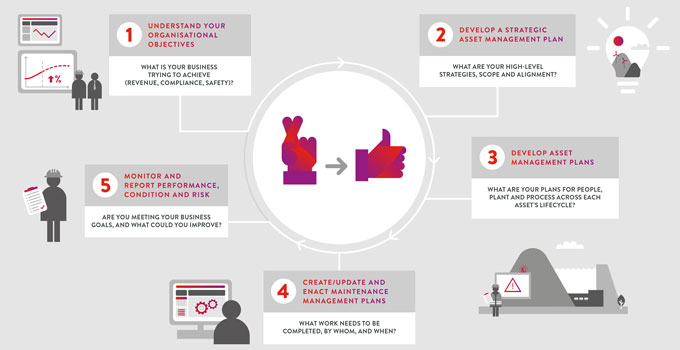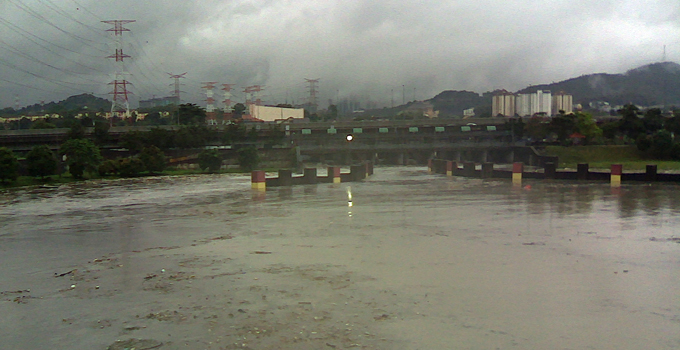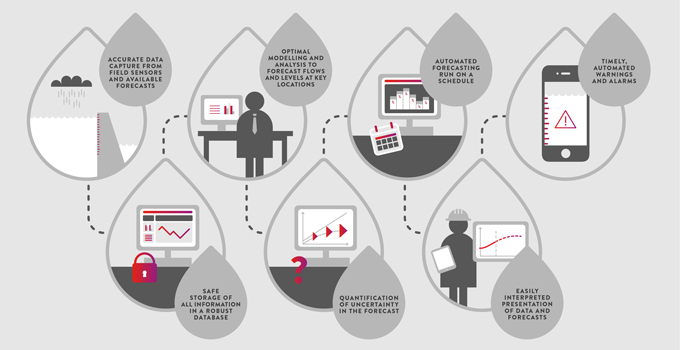Are you an asset manager or an ‘asset guesser’?
In the hydropower sector, we’re all trying to do more with less. And as hydropower assets age, there’s always more to be done.

Gut feelings and guesswork won’t be enough if you want to make the best use of your asset management budget and keep your assets safe, reliable and profitable.
Today, ‘asset management’ is a much more sophisticated practice than twenty to thirty years ago. Back then, we’d refurbish or replace components at fixed time intervals (whether the work was needed or not), hoping that this would prevent or reduce breakdowns and forced outages. In most cases, this sort of scheduled maintenance was based on original equipment manufacturers (OEM) recommendations, best guesses or a mixture of both with very little evidence of root causes of actual or potential failures identified.
This maintenance attitude led to repeated failures. It also resulted in short-term planning. And, because of a lack of good evidence that current maintenance approaches were achieving direct positive business returns either in plant or financial performance, it increased the pressure to reduce maintenance budgets.
Asset management today
Hydropower assets are increasing globally, both in number and in size. So too, our knowledge of hydro assets continues to strengthen. We have much better understanding and insights now into how and why these assets wear out, how they behave, why they fail, and the ways in which they respond to various operating conditions and environments.
Operating conditions are constantly changing due to variables in the energy market, power purchase agreements, increasing expectations of customers, changing technologies and regulatory requirements, and more. So asset management needs to be flexible and to respond to the evolving context.
Today, ‘asset management’ is a trendy term – but there’s a very broad spectrum of practice across the hydropower industry, and it is a long path from basic approaches through to achievement of superior methods and strategies.
To achieve the lowest lifecycle costs for assets, as well as to minimise forced outages and breakdowns, power and water businesses need to see asset management as a crucial component of risk management and business strategy. It also needs to be viewed as an incremental journey of improvement, supported by processes and structures based on standards.
Ideally, your asset management policy, strategy, plans and activities should be based on the ISO/AS 55000 series of standards. The ISO 55000 standard series encourages aligning asset management with your broader organisational objectives, context and plans – and recommends that you regularly revisit this to be sure that alignment is maintained. This can now filter through your asset management policy and strategic asset management plan (SAMP), and be embedded in the reality of implementing your asset management plans.
In other words, your asset management policy provides direction which is aligned to your organisational context; your SAMP translates this; and your asset management plans act as the catalyst to create and sustain change in leadership, culture and asset management practice.
People, plant and process
Alignment with the principles of the ISO/AS 55000 standard series are fundamental to achieving the lowest lifecycle costs for hydropower assets. For success in your business you need to consider not only the physical asset but the entire delivery process, you need to understand what is required in each of three ‘P’s – people, plant and process – and you need an implementation plan to get you there.
Without people, we don’t have plant. Having the right people involved, right from conception, can make the difference between successful projects with years of profitability and projects that face years of increased expenditure and issues to manage. Ensuring that the right people have the right skills, training and competencies to carry out the right maintenance at the right time is paramount to achieving the plant performance you desire.
When it comes to plant, we recognise that, ultimately, all assets have a finite life – but our increasing knowledge of asset behaviour can help us to design components better for longer life and for greater cost-effectiveness and efficiency. By developing and implementing the right asset management techniques, you will increase the likelihood of your assets being profitable, reliable, available and safely operated – and staying that way. A strategic investment in asset management will more than pay for itself through increased benefits and decreased risks.
Turning to the ‘process’ element, we should recognise the importance of assessing, organising, planning, budgeting and reporting on the work effort – but there’s a need to ‘keep the processes real’. In other words, don’t implement processes for the sake of it, nor to try to address or mask problems in other areas that would be better to rectify than to over-manage. Processes should support the integration of the broader organisational context into operations and maintenance and then help to assess and report on effectiveness and performance.
By bringing people, plant and process together, and aligning asset management with your business vision and decision-making, you are far more likely to be able to get the best out of your valuable assets. And you’ll achieve a culture of continuous improvement and proactive, prioritised action – leaving no more room for reactivity and guesswork.
If you would like to discuss how Entura can assist you with assessing and managing your hydropower plants or other power or water assets to minimise risk and maximise efficiency and useful life, please contact Leigh Smith on +61 419 884 318.
About the author
Leigh Smith is a specialist consultant with extensive experience and proven ability in asset management, condition assessment, risk management and project management in the power sector, particularly hydropower. He has over three decades of practical experience with hydropower assets and has successfully delivered and project managed many major projects in Australia and internationally. Leigh has produced numerous asset management plans to support financial modelling and feasibility of major hydropower projects, as well as detailed 30-year asset management and maintenance plans that have been critical to the progression of projects around the world.
MORE THOUGHT LEADERSHIP ARTICLES
Size isn’t everything when it comes to dam risks: a ten-point plan for safer dams
The failure of a dam in July 2018 in Laos highlights again how crucial it is that dams are designed, constructed and operated safely – regardless of their size.
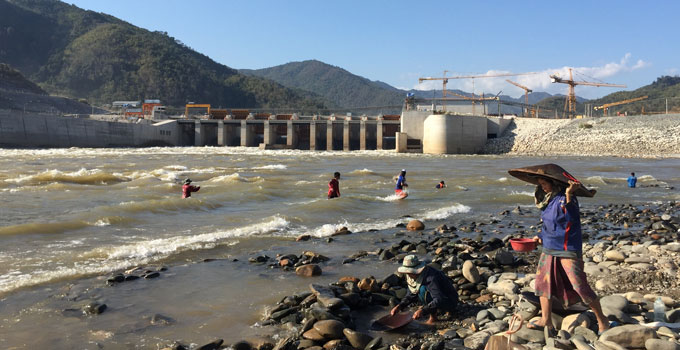
Dams provide many essential benefits – such as water supply, irrigation, power generation, flood mitigation, drought management and recreation – but we must always ensure that these values are carefully balanced against any level of potential risk the dam may pose to its community and environment. When a dam is designed, constructed and operated according to current best practice, it’s highly likely to be safe.
Dam risk is the combination of the chance of dam failure, however small, and the consequence of that failure. We need to ensure that the level of risk is minimised to what is considered ‘acceptable’ by society. This level of risk can then be compared against other risks that society accepts, such as in the aeronautical, chemical or electrical industries.
If a dam has a high hazard (or consequence) category, its chance of failure must be remotely small, ensuring that the risk to society is acceptable. A dam with a higher hazard category requires higher engineering and operational standards. This is a fundamental concept for dam owners and developers, and is crucial to ensure an acceptable dam safety risk.
The only way that the level of hazard can be properly determined is through adequate consideration of the potential downstream consequences of the dam’s failure. The guidelines of the Australian National Committee on Large Dams (ANCOLD) have renamed the ‘dam hazard category’ to ‘dam consequence category’ – highlighting that the hazard category should be based on potential downstream consequences. Regrettably, the dam hazard category given in international dam safety guidelines are still based only around dam height and reservoir volume.
The failure of the saddle dam at the Xe-Pian Xe-Namnoy hydropower project under construction in Laos illustrates that the height of a dam is not the major determining factor of that dam’s hazard category. The fact that this saddle dam was only 16 m high did not make it less of a hazard than the main 78 m high dam.
In some situations, saddle dams can even pose a higher level of hazard than the higher main dams because of the great volume of water stored in the upper part of the reservoir, the lower level of surveillance and emergency planning at the saddle dam than at the main dam, and the fact that water flow downstream is not usually expected from a saddle dam so the population downstream may be larger as well as less aware of potential risks.
So how can we ensure an acceptable level of safety? Here’s our ten-point plan for safer dams
1 – Assess the downstream consequence through dam break modelling
Dynamic hydraulic modelling software can be used to model hypothetical dam failure, quantifying the likely downstream flood wave such an event could generate. Based on this modelling, you can map the flooded area and determine the downstream consequences for life safety, property damage, economic impacts, environmental and heritage damage, and social impacts such as employment, health and wellbeing. Now, the dam’s hazard (or consequence) category can be determined, forming the basis for the design criteria and operational requirements.
2 – Adopt the appropriate design standards for the hazard category
In most international guidelines, the hazard category of the dam determines the design criteria. The greater the downstream consequence, the more stringent the design criteria adopted. However, every dam site is unique, so it is not always possible to design everything according to a general design standard because there simply isn’t a design standard for everything. This requires good engineering judgement. A framework for that judgement is a failure modes analysis for the dam.
3 – Undertake a failure modes analysis
A failure modes analysis identifies the sequence of events that need to occur to lead to dam failure. This process will help to identify the key issues associated with the particular dam site. It will focus the design effort on the elimination of the specific failure modes for the particular dam. It is vital that the dam foundation and reservoir impoundment are considered, and that credible failure mechanisms associated with geological defects are identified and assessed.
4 – Use experienced contractors and ensure quality control
The design engineer must be involved during the construction phase to ensure that the design intent is fully captured and that any changes are carefully considered so that no new failure modes are introduced. Unless the dam is constructed in accordance with the design documentation (the drawings and specifications), there’s no guarantee that the dam will comply with the design criteria and perform as intended.
5 – Implement appropriate dam safety principles during construction
These principles include ensuring adequate flood capacity, dam safety monitoring (especially if water can be stored behind the dam) and dam safety emergency plans. An effective dam safety emergency plan should be active and appropriately updated during all phases of a dam’s life cycle – during construction, first filling, ongoing operation and during major dam upgrades.
6 – Ensure adequate governance through an independent review panel
An independent review panel should be part of any dam engineering project involving a high hazard, to ensure adequate governance and identification of all hazards and potential failure modes. Most large-scale civil projects will encounter the competing demands of time, cost, quality and safety. However, the independent review panel will ensure that no corners are cut in quality or safety in the drive to meet budgets and schedules.
7 – Heighten scrutiny of the dam during unusual events
Unusual events such as the first filling, major floods or major seismic events require increased attention to dam observations and/or measurements. In these circumstances, surveillance needs to be more frequent, via both physical inspections and monitoring with instrumentation. If anything unusual occurs, a response should be initiated through the dam safety procedures in the dam safety management plan. The initial response will be to further understand what is occurring, and determine if it is a dam safety issue or not. It is good practice that dam engineers are involved during unusual events to interpret information and advise the owner.
8 – Maintain an appropriate dam safety program
Long before the dam is filled, the dam safety program should be underway, including operational instrumentation, regular routine inspections, and the personnel and systems in place to make the necessary decisions should any unusual observations occur. Dam engineers can provide ongoing advice to owners when in-house capability is lacking, and can offer an independent set of eyes to ensure currency of the existing systems.
9 – Check your dam safety documentation
Ensure that key dam safety documentation is present, relevant and kept current, including a dam safety management plan, dam surveillance plan, dam operation and maintenance plan, dam safety emergency plan, and evacuation plan.
10 – Consider a dam portfolio risk assessment, regardless of dam size
Even if you think a dam is unlikely to create a high risk, it is worthwhile confirming this, so that you can ensure the appropriate level of dam safety management. If you own a portfolio of dams and you are not sure whether you are exposing society to an unacceptable risk, you should consider a dam portfolio risk assessment to confirm the safety status across your suite of assets. As we’ve indicated, small dams don’t necessarily mean smaller risks .
Running a portfolio risk assessment across numerous small dams may indicate that some have more than a negligible risk, particularly in terms of their criticality to the business or previously unidentified life safety risks. These small dams can then be rolled into your broader dam safety program to ensure that, despite their small size, they are assessed, operated and maintained in alignment with their risk, as for your larger dams.
Whatever the size or purpose of your dam, safety needs to remain your top priority. These ten steps form a best-practice pathway so you can be sure that you’re doing everything possible during dam design, construction and operations to minimise the chance of dam failure and its downstream consequences.
To discuss how Entura can support your dam safety activities, please contact either Richard Herweynen on +61 3 6245 4130 or Shekhar Prince on +61 412 402 110.
About the authors
Richard Herweynen is Entura’s Technical Director, Water. Richard has three decades of experience in dam and hydropower engineering, and has worked throughout the Indo-Pacific region on both dam and hydropower projects, covering all aspects including investigations, feasibility studies, detailed design, construction liaison, operation and maintenance and risk assessment for both new and existing projects. Richard has been part of a number of recent expert review panels for major water projects. He participated in the ANCOLD working group for concrete gravity dams and is the Chairman of the ICOLD technical committee on engineering activities in the planning process for water resources projects. Richard has won many engineering excellence and innovation awards (including Engineers Australia’s Professional Engineer of the Year 2012 – Tasmanian Division), and has published more than 30 technical papers on dam engineering.
Paul Southcott is a specialist civil engineer at Entura. He has more than 28 years of professional expertise in civil and dam engineering, as well as expertise in geotechnical, foundation, structural, hydraulic and hydropower engineering. Paul’s dam engineering experience spans geotechnical and hydrological investigation; feasibility and options studies; concept, preliminary and detailed design; engineering assessment, consequence assessment and risk assessment; safety reviews; monitoring and surveillance; and emergency planning. He has extensive experience in dam risk assessment including as project manager for Hydro Tasmania’s, Taswater’s and SAWater’s portfolio risk assessment projects. He was a member of the ANCOLD committee that issued the Guideline on Consequence Categories for Dams in 2012.
MORE THOUGHT LEADERSHIP ARTICLES
What can dam owners do to better manage floods and avoid the blame game?
To keep communities and assets safe during flood events, dam operators need to make rapid and difficult decisions. The best protection is having the right systems in place before an emergency arises.
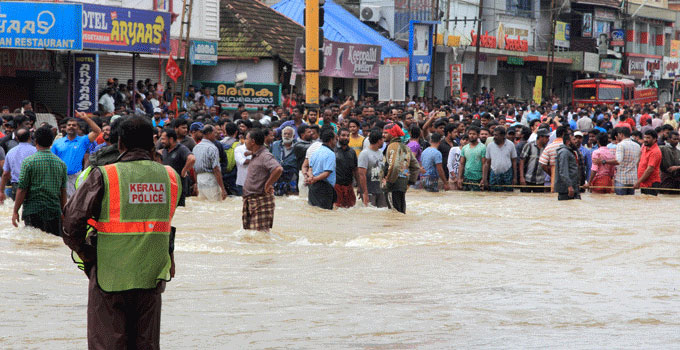
Dam operators are sometimes blamed for causing flood disasters due to the way the dam was operated during intense rains, such as by suddenly releasing water through gates and valves. Yet this criticism is not always warranted, as these actions may have only been one part of the problem associated with the flood. At times, sudden releases may be necessary to maintain the safety of the dam, as the dam’s failure would have even greater consequences than the additional flooding due to the releases.
In 2010 and 2011, Australia experienced some of its biggest flood events, with large areas of Queensland declared disaster zones. At the time of the Queensland floods, there was significant scrutiny of how Wivenhoe Dam was operated, even though it was part of the engineering system designed to mitigate flood risks. Blame and criticism abounded. Individual flood operations engineers were criticised for making poor decisions. The managers of the dam operator were blamed for not drawing down the dam at the beginning of the wet season despite a long drought immediately prior to the floods. The Bureau of Meteorology was criticised for not providing adequate warnings and for inaccurate forecasts. Planners were blamed for allowing development in flood-prone areas. Local authorities and engineering consultants were harshly scrutinised for their modelling and analyses.
Fast forward to 2018, when devastating floods in Kerala, India, resulted in significant loss of life, displacement of people and extensive damage. In this circumstance, blame has been directed at the dam operators, government authorities, planners, flood forecasters, and dam management bodies. Media articles have called it a ‘man-made disaster’, and claims have been made that water should have been discharged earlier from the reservoirs prior to the monsoon, that gates should have been opened gradually, that better warning should have been provided, that power stations should not have been out of action due to maintenance, and that other dam functions such as water supply and power generation should have been secondary to flood mitigation.
Decision-making about dams can be complex, especially given that most dams have more than one purpose: they may supply water for drinking and irrigation, as well as provide flood mitigation benefits for downstream communities. However, the way a dam is operated for both these purposes may be very different and frequently conflicting. For example, a dam for water supply aims to maximise stored water to safeguard supply during droughts; however, a dam for flood mitigation needs as much free space as possible in the reservoir to mitigate the downstream flood risk. Climate change is likely to increase the conflict between water supply and flood mitigation as more severe droughts and floods are anticipated, which will increase the challenges for dam operators – so it is critical that we learn from events such as these examples from Australia and India.
So what can a dam owner do to better manage a major flood event?
The enquiries and reviews that followed the 2010/2011 floods in Australia overwhelmingly indicated the need for improvements in non-structural measures such as development planning, the production and availability of quality flood management information, emergency response management and community participation. The owner and operator of Wivenhoe Dam also discovered the importance of maintaining up-to-date, clear and unambiguous dam flood operating rules, and the need to follow these flood operating rules at all times.
The following seven elements should be in place for every dam owner who wants to better manage major flood events:
1 – Flood forecasting systems
Flood forecasting is critical for protecting public safety and preserving infrastructure. Effective flood forecasting systems provide accurate and timely warning of impending floods. Longer warning times provide greater opportunity to activate emergency management or evacuation plans and to manage water infrastructure. Although the intent of a flood forecasting system is to provide the most accurate forecasts possible, the reality is that there are limitations, especially during major flood events. Reviews undertaken of the 2010/2011 Queensland floods indicated issues with flood data collection and the need for improvements in the coverage of warning networks.
Flood forecasting depends on the timely availability of high-quality data from the right locations in a catchment. Without good real-time telemetered rainfall and streamflow data it will be difficult to develop a dependable flood forecasting system that can be used for real-time decision-making. There needs to be some redundancy in the system because some of the instruments and/or communications systems may fail during a major flood event. This requires an investment both to install and to maintain these instruments. With numerical weather forecasts increasingly available, there is now an opportunity to use this data in flood models to provide even longer lead times for action.
2 – Adequate catchment planning
Catchment-scale management is needed to manage flood risks. Developing flood inundation maps and understanding the consequences of upstream dam failures provide an opportunity for appropriate land use and planning controls downstream, minimising loss of life and property. These tools also provide a basis for developing appropriate structural and non-structural flood mitigation measures and emergency management plans.
3 – Operational model for dam infrastructure
A dam operator needs an operational model that is either linked to the flood forecasting model or embedded in it. If the river system has a cascade of dams, the entire cascade should be modelled as one system, as the operation of each dam affects other linked dams. Understanding these complexities will be critical when managing a major flood event, so that cascade impacts can be assessed and determined prior to implementing an action. Maximum flood mitigation can be achieved by operating linked dams together. Outside of a flood event, these operational models can be used to run potential flood scenarios to help develop clear operational procedures guiding the operation of the dams during a flood event and to train operators so they understand their critical role.
4 – Clear operational procedures for dams during flood events
Given the potential significant impacts on communities downstream, it is imperative that dams are operated during flood events in accordance with clearly defined operational procedures to protect the structural safety of the dams and minimise impacts to life and property. Importantly, all operational decisions during flood events must be documented when they are made, not retrospectively. Pre-releases may be part of these operational procedures, including seasonal targets for reservoir levels to help mitigate flood risks associated with a defined wet season.
Certain triggers (e.g. reservoir level, flood predictions) will shift normal reservoir operation to flood operation. Given infinite possible flood scenarios, it is not always possible or appropriate to provide completely prescriptive flood operating procedures. The manual of operational procedures must be designed to guide decision making based on professional judgements by qualified engineers, ensuring the decisions are robust for all circumstances. When making decisions about releasing water from dams during flood events, consideration should be given to rain falling in catchments not controlled by the dams. Operational decisions must be linked back to the wider flood forecasting system.
5 – Dam safety emergency plans
All high-hazard dams should have a dam safety emergency plan (DSEP, or sometimes called an emergency action plan, EAP), which forms an important part of the overall dam safety management procedures and dam safety documentation. The purpose of a dam safety emergency plan is to provide procedures for the dam owner to manage the dam during an emergency (whether flood, earthquake, or major dam safety incident). The plan needs to clearly outline who does what and when and usually has graded levels of response as the incident develops. A major flood event should trigger the procedures of the dam safety emergency plan, providing a heightened level of awareness of the performance and safety of the dam.
It is important that this plan has clear roles and responsibilities and clear communication channels both internally and externally to emergency services and the media. Clearly documenting the decisions and communications throughout the emergency is critical, and all involved should keep detailed logs of events. This allows effective debriefing after the event to identify improvements to the plan and, in the worst case, will assist in defending any legal action. If at any point the dam is at risk of failure, a dam safety emergency will be declared and emergency services must commence evacuation.
6 – Flood evacuation plans and flood management centre
Flood evacuation is generally the responsibility of the affected state or district’s emergency services. Flood evacuation plans are prepared as part of the planning process for mitigating the risk associated with a major flooding event. Floodplain mapping forms a part of any flood evacuation plan. These maps show the area that will be flooded in various magnitudes of floods.
Evacuation plans will determine when people need to be evacuated and by what routes, before these evacuation routes are flooded. They will clearly nominate where evacuation centres will be set up on non-flood-prone land with necessary food, water and sanitary facilities. Setting up a centralised flood management centre will help to provide a focal point for information, communication and decision-making throughout the flood event, ensuring clear governance, oversight, roles, responsibilities, communication and cooperation.
Severe flooding is likely to disrupt power and communication systems so available back-up need to be planned, including portable generators, radios and satellite phones. Modern communication tools such as mobile phones are increasingly allowing widespread communication of flood warnings, as well as audit trails of warnings so that post-flood reviews can improve emergency management and evacuation procedures over time.
7 – Community education and awareness
Effective flood evacuation is only possible if the downstream community is aware of the risk and the action they need to take following certain warnings. This awareness is best achieved through community information sessions. Working with communities before a disaster strikes will put them in a better position to deal with its impacts. The 2010/2011 Queensland floods showed that helping people to become more self-reliant is of benefit if/when emergency services are overwhelmed. To achieve this, flood risk information and flood predictions should be publicly available, along with education and clear communication.
These seven factors are not the sole responsibility of a dam owner; instead, cooperation is needed among authorities, and dam owners should encourage and facilitate this. Using a framework based on these seven components, dam owners will continually improve flood management, better securing the safety of people and property downstream, as well as minimising the likelihood of significant reputational and legal risks.
To discuss how Entura can partner with you to better manage dam safety and flood-related risks, contact Richard Herweynen on +61 3 6245 4130.
About the authors
Richard Herweynen is Entura’s Technical Director, Water. Richard has three decades of experience in dam and hydropower engineering, and has worked throughout the Indo-Pacific region on both dam and hydropower projects, covering all aspects including investigations, feasibility studies, detailed design, construction liaison, operation and maintenance and risk assessment for both new and existing projects. Richard has been part of a number of recent expert review panels for major water projects. He participated in the ANCOLD working group for concrete gravity dams and is the Chairman of the ICOLD technical committee on engineering activities in the planning process for water resources projects. Richard has won many engineering excellence and innovation awards (including Engineers Australia’s Professional Engineer of the Year 2012 – Tasmanian Division), and has published more than 30 technical papers on dam engineering.
MORE THOUGHT LEADERSHIP ARTICLES
Are batteries the best way to go?
Renewables are now the cheapest form of new energy generation, but to make variable renewables ‘dispatchable’, we need to add storage. Are batteries the best way to go?
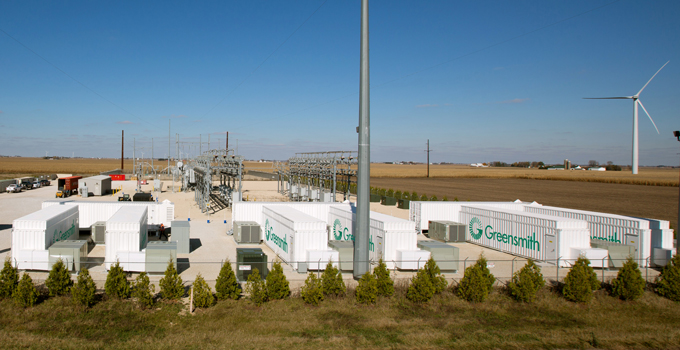
Batteries have been around for more than a century, but now we’re wanting them at a much larger scale. This is driving rapid advances in battery technology, ramping up capability and pushing down costs.
With batteries having such huge potential, this is the time to build a better understanding of battery technologies and applications. Batteries are a key element in addressing the complexity of achieving ‘dispatchable renewables’ and providing the necessary and complex functions of load balancing and network support.
As we plan how to include batteries in our energy future, we need to temper the hype with a careful, informed and strategic approach.
Shifting the load, stabilising the grid
A good place to begin is by clarifying what batteries do. The two main functions are load shifting and grid stabilising. In this article, I will focus on lithium batteries as they are the market leading technology at present. Of course there are other technologies that will forge a place in the “battery mix”, both chemical and other storage.
Load-shifting batteries are designed to better match generation to daily load cycles – for instance, storing excess solar generated in the day so it can be used at night – so they normally operate on a daily cycle. This is the most widely understood application of a battery in the wider community, but they require large amounts of storage (typically 4 hours for solar) and are currently too expensive to be realistically applicable.
With every charge/discharge cycle, battery life reduces, and this comes at a cost that is beyond the average cost of energy (except in some off-grid and remote mini-grids). If the battery is used for shifting energy only at times when the electricity price is high, this low level of utilisation will push up the unit cost of generation.
As battery prices come down over time, these issues will become less important. As major coal plants retire over the next decade in Australia, demand for load shifting will increase , which will also contribute to greater viability of battery solutions. However, pumped hydro is another major player to watch in the load-shifting arena, and may be difficult to beat, especially as a long-term storage solution.
The other main function of batteries is in supporting the stability of the grid. Grid-stabilising batteries can increasingly provide a whole raft of support functions such as FCAS (frequency control ancillary services) and NSCAS (network support and control ancillary services). This is mainly driven by very rapidly improving capabilities of the power electronics and control of the power conversion system (PCS) – the AC-DC converter – but is also supported by high-power battery technologies that can provide substantial power capability to support the grid without requiring much storage.
This type of battery really punches above its weight, providing short-term energy that can support most of the localised issues that arise in parts of the grid. These batteries could provide the glue needed by an increasingly fragmented grid. Right now, though, the need for these batteries is not widespread. Grid stability may be the most useful function of a battery into the future, but it is not well understood in the broader community.
The state of play
There’s plenty of hype about batteries, but at the utility scale we are yet to see great uptake in terms of numbers. The exceptions are in unique locations – areas of constraint on the network or on generation, where batteries can offer some grid support. Many of these are in South Australia; some in the rest of the NEM.
Additionally, batteries are being included in project planning as mitigation against future storage costs, penalties or other obligations that may occur under future legislation, regulation or market arrangement.
In smaller grids, solar intermittency can cause issues for the ramp rate, which offers batteries an opportunity – but these cases can also be addressed by other measures such as forecasting, constraint and control, or possibly a smaller battery.
A foreseeable future
What about the future? Batteries don’t generate energy – so, like network costs, batteries will need to be minimised to form an efficient grid. We think that the exceptions will increase, but still remain exceptions and tweaks to keep the network functional.
All of the many published studies of high renewable energy systems indicate that future grids will depend on a dynamic interplay between different generation types, strongly supported by interconnection for geographical distribution and strengthening. Batteries will be included strategically where required to provide grid support functions, and often this will mean co-location with a renewable generator. We’re definitely not going to see every renewable generator producing output on demand like a gas plant.
Taking a long term view, the future retirement of coal generators will inevitably produce a need for longer term storage or load shifting. Pumped hydro is a major contender here: projects such as Snowy 2.0 in NSW or Tasmania’s ‘Battery of the Nation’ can fill part of the requirement, supported by other smaller but targeted projects. While pumped hydro is being developed in readiness for or in sync with forthcoming retirements of coal-fired power stations, the market is also starting to see the need for more roll out of utility-scale batteries.
In this context, it’s often said that batteries will never serve the function of pumped hydro, but we should challenge this assumption. Large-scale battery deployment is conceivable with DC coupling of batteries with a solar plant (avoiding duplication of inverters). And the learning curve for battery prices coupled with higher efficiency and flexibility could within 10 years make such a solution competitive with pumped hydro for up to 4 to 6 hour storage (the timeframe in which load shifting will become important by then). Time and economics will tell.
Going behind the meter
We would be remiss not to mention grid-connected behind-the-meter batteries for domestic and commercial customers in this discussion. Even though the choice to install is not easily rationalised (and perhaps fuelled by non-cost-reflective customer pricing), significant numbers of customers are going ahead. This can act as an evolving distributed storage resource.
While smart grids have been touted as the means to utilise this storage resource, there is also the likelihood of a more organic utilisation because of the fine granularity of this storage. Opportunities are already emerging for market aggregators to utilise blockchain technology and the internet to extract the best value from these batteries at any given time. This trend may defer some of the requirement for large-scale storage for a limited period.
It is still early days…
A certain amount of caution is warranted as we move to embrace rapidly evolving battery technologies. Batteries are highly proprietary, so their functional nature, capabilities and controls can vary widely and are rarely transparent, and there is not yet a functional standard for their specification or operation. This creates a degree of risk, and calls for experienced guidance in specification, procurement and testing in particular. This situation is evolving, but agreement and standardisation take much longer than technology development.
That’s not to say we shouldn’t be excited. Batteries offer extraordinary potential for enabling higher proportions of renewable generation in our energy future . There’s just still work to be done to help industry fully understand the technology and its applications, so we can be confident of getting the best out of batteries in a network context.
If you would like to find out more about how Entura can help support you with storage options for dispatchable renewables, please contact Patrick Pease or Chris Blanksby on +61 408 536 625.
About the author
Dr Chris Blanksby is a Specialist Renewable Energy Engineer and Entura’s lead solar energy specialist. He has undertaken and published research on the solar resource in Australia, and has led several due diligence and owner’s engineer projects for wind, solar and microgrid projects in Australia, the Pacific and Asia, including over 20 MW of battery projects.
MORE THOUGHT LEADERSHIP ARTICLES
Rethinking the role of hydropower in Australia
Although hydropower is older than wind and solar generation and battery storage, its role in Australia and around the world has never been more important.
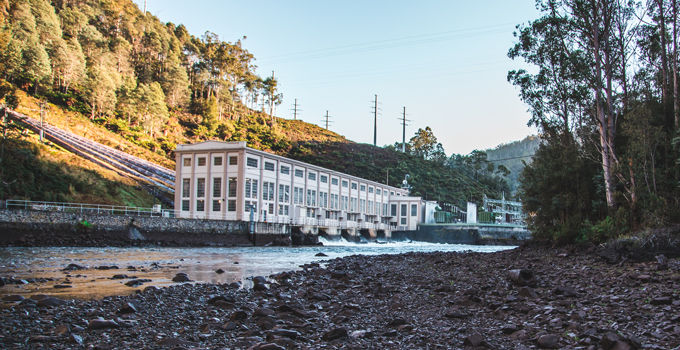
Hydropower is still by far the largest contributor to the world’s total generation of renewable energy. The fact that this old technology is still very much alive today shows that hydropower can stand the test of time and help us meet the challenges of the future.
As the proportions of solar and wind generation rapidly rise, and as we see a gradual retirement of existing thermal generation and reduced construction of new thermal generation, the role for hydropower – both in Australia and internationally – continues to broaden and build.
New opportunities for hydropower
There’s no need to see rapidly emerging and increasing new technologies as a threat to hydropower. This isn’t a winner-takes-all environment. Rather, new opportunities are emerging for hydropower as an enabler of integrated renewable developments by providing the storage needed to smooth the intermittency of weather-dependent renewables – creating ‘dispatchable’ renewable energy.
In the last couple of years, particularly since blackouts in South Australia in 2016 and nationwide rises in electricity costs, debate about energy affordability, sustainability and reliability has become both mainstream and continuous. The pressure has never been greater to find the cheapest, cleanest power that is available whenever and wherever it is needed.
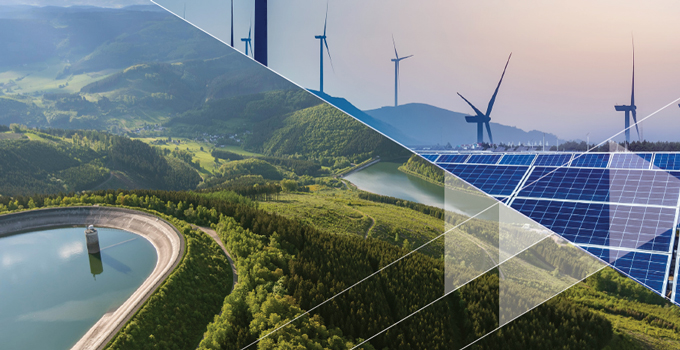
It is well known that traditional hydro schemes can provide baseload power or peaking power, grid stability services, and availability to fill in the gaps when intermittent renewables aren’t generating. However, the recent resurgence in interest in pumped hydro offers something extra: the ability to use excess available generation from wind and solar to pump water uphill into storage so that it can be used for electricity generation later – and this is why it can be described as a ‘battery’.
But how does pumped hydro compare with ‘actual’ batteries? Will rapid improvements in battery technology displace pumped hydro as a preferred storage solution? Technology is advancing very quickly in batteries, but I’m convinced that there are still some major differentiators that create space for pumped hydro.
One advantage is that we have a greater understanding of pumped hydro’s lifecycle costs and sustainability, whereas there are still a number of uncertainties in this respect for newer technologies such as batteries.
Also, critically, while batteries may be a good solution for low-power, short-term storage, they are not yet capable of providing the frequency and voltage regulation required by a grid with a high proportion of intermittent renewables. Batteries also typically cannot supply the significant level of output over a longer duration that pumped hydro energy storage or traditional hydropower can make possible.
Pumped hydro and modified traditional hydropower solutions will be needed for smoothing daily variability as wind and solar plants expand in number and size. And it is really only traditional hydropower with large reservoirs that will be able to provide the multi-day storage needed in extreme events of both low wind and low solar.
Achieving full dispatchability of combined wind and solar PV power will depend on utilising pumped hydro storage and existing hydropower storages to their full potential.
If the future of both traditional hydropower and pumped hydro is strong, why have no new pumped hydro projects been built in Australia in thirty years? What is needed to not only get it going in Australia, but also to make sure we get it right?
I believe that three crucial elements to realising hydropower’s future and ‘getting pumped hydro right’ will be identifying the most viable sites, developing a sound business case, and ensuring that we invest in the skills and capacity we’re going to urgently need in the future.
Identifying the most viable sites
A critical element for pumped hydro success is identifying a viable project – where the right site and the best design can come together into an optimal mix of capacity and cost. Entura has done a lot of work in this area, and we have developed a methodology to filter the many hundreds of potential pumped hydro sites across Australia down to the most ideal.

This methodology has enabled us to develop a real-world, relevant and practical pumped hydro atlas of Australia identifying project opportunities from many thousands of theoretical possibilities.
Our atlas has already been used to shortlist potential pumped hydro sites for the Battery of the Nation initiative in Tasmania, and it identifies many more promising sites and opportunities for developers in states such as South Australia, New South Wales and Queensland. And the nation has room for many more batteries.
Building a robust business case
We’ve often said that a project won’t get over the line on the base of technical viability and environmental benefits – in the current market, the dollar wins. So pumped hydro needs some level of predictability in its revenue streams. As the dynamics of arbitrage change, we need to explore a range of other revenue opportunities. And that’s a complex forecasting challenge.
Part of the solution may be price insurance and a value placed on providing network support services and firming. Another part is behind-the-meter generation and integration – such as in the Kidston project, in which pumped hydro is coupled with a large-scale solar farm, and potentially wind generation, to form a renewable energy hub.
Investing in capacity development
To me, a third critical component is investing in talent, skills and capacity. This is a global issue as much as an Australian one. To prepare our industry to adapt to change as well as to drive further change in the sector we will need to harness talent and upskill and transition workforces.
This is the kind of strategic whole-of-business workforce planning that we encourage our clients to adopt, and it will be crucial over coming years and decades.
I am excited about the future of both traditional hydropower and pumped hydro. I firmly believe that if we value hydropower as a key player in the future mix of technologies in our energy markets, we can solve the energy trilemma at home and around the world.
About the author
Tammy Chu is Entura’s Managing Director. She leads Entura’s business strategy, performance and services to clients, and is part of Hydro Tasmania’s Leadership Group. Tammy joined the business in 2000 and has held a range of positions at Entura, from Technical Professional to Project Manager, Business Development Manager and Water and Environment Group Manager.
As a civil engineer, Tammy specialised in the design and construction of mini-hydro and hydropower systems, project management, hydropower investigations, prefeasibility and feasibility studies, environmental assessments and approvals, resource investigations and resource water management.
Tammy is a member of the Board of the International Hydropower Association. She was the first female and now past president of the Tasmanian Division of Engineers Australia, and was an Engineers Australia National Congress representative.
Tammy holds a Master of Business and Administration from Chifley Business School, is a Fellow of Engineers Australia, and a graduate of the Australian Institute of Company Directors.
MORE THOUGHT LEADERSHIP ARTICLES
Asset management trends for profitable wind farms
How can a wind farm realise its full lifetime potential in an increasingly cost-sensitive market?

Until now, improving the wind industry’s profitability equation has been driven by increasing the size and efficiency of wind turbines, resulting in more energy produced for every dollar of capital expenditure. However, there’s only so far we can go with this approach.
To keep driving costs down and maintaining your wind farm performance, we now need to turn our focus to another aspect of the equation: a wind farm’s significant ongoing operational and maintenance (O&M) costs, which are set to increase as wind assets age. Achieving maximum yield at minimum risk and cost across a wind farm’s full operational life is a major asset management challenge, and much is yet to be learned.
In 2018, at the Wind O&M EU conference in Germany, I observed some international trends and perspectives on O&M that can offer useful insights for the wind industry in Australia. Although some aspects of the topic generated a deal of consensus, other areas are far less certain with many questions and possibilities yet to be fully explored.
Learn from other industries
Across the wind industry, there’s strong agreement that commercial returns for wind farms are not as high or as easy to obtain as they once were, and that reducing O&M costs on wind farms is critical when profit margins are being squeezed.
This may seem obvious, but the fact that we still need to articulate this point demonstrates that the wind industry has a significantly less sophisticated O&M approach than more mature industries such as oil, gas, other energy and heavy industries, and the IT and telecommunications sectors.
The wind sector should, and no doubt will, look to these more mature industries in the coming years for innovations that can be applied successfully to streamline our O&M and asset management strategies.
Plan for a longer life
Another implication of the relative youth of commercial wind farm development is that the industry has little practical experience with ageing wind farms – yet wind farms are set to get even older. Where it was previously the norm for a wind farm’s business case to be based on a 20–25 year life, it is becoming increasingly common for business case scenarios and asset management strategies to consider lifetimes up to and potentially beyond 30 years.
We need to be developing thorough and sophisticated asset management strategies that fully embrace the later stages of a wind farm’s life – not only the earlier stages in which O&M may have been conducted under contract with risks managed very effectively.
When we think about ageing wind farms, we weigh up the choices of continuing operations, decommissioning, or repowering with new turbines. From our understanding, it seems that wind farm repowering is only happening in locations with very friendly tariffs (such as a few areas in Germany), or where the existing project is fundamentally unsound from a technical and commercial perspective.
In Australia, full repowering with new wind turbines is not currently a commercially attractive proposition, and may not be widely considered for at least another decade. So, a wind farm’s extension of life will need to be achieved through effective O&M and refurbishment. I observed that some wind turbine owners and suppliers are beginning to think in more sophisticated ways about whole-of-life asset management strategies that maximise project value for the longer term, but it is still early days across the sector.
I also noted a range of diverging opinions about whether it is preferable for an owner to manage O&M through long-term comprehensive O&M contracts or whether risk is better mitigated by owners taking on the management of O&M themselves. Approaches vary depending on portfolio size, experience, capability and the general philosophy of the business. Clearly, this is not an area in which one solution will work for all.
Share information to build knowledge
Given the relative newness of the large-scale wind industry, and the need to squeeze every last drop from existing infrastructure, there is much to be gained from learning from and with each other.
Many industry players at the conference expressed a desire to see increased cooperation and sharing of information between different owners, operators and manufacturers.
The industry as a whole will benefit if SCADA system data is the property of the wind farm owner and shared more openly across the industry. Greater openness and availability of data will allow better benchmarking across turbine models scattered across the globe, enabling operators to better predict future costs and performance and incorporate reliability-centred maintenance.
Better benchmarking may offer insights into the extent of the performance improvements that could be gained on existing projects by adopting some available upgrade options. Many service providers are offering control system upgrades, aerodynamic improvements, yaw alignment systems, and advanced condition monitoring systems for increased availability – yet the industry is still learning how to translate this dizzying variety of rapidly developing technologies and options into a robust business case.
It can be difficult for owners to justify expenditure when the gains are uncertain, difficult to measure, and sometimes accompanied by drawbacks that are hard to quantify directly. For example, do you take increased generation at the risk of a reduced lifetime or increased maintenance costs?
If performance improvements of wind projects were more easily measured, we could more realistically quantify their impact on profit.
From these trends, observations and uncertainties, it’s clear that in any wind farm project – whether developing a new project or changing ownership of an existing project – we need to look very carefully at ongoing O&M costs, particularly as the increasing costs of end-of-life loom large. Thorough due diligence and realistic assumptions in this area will be vital for developing viable business cases across an increasing range of possible lifespans.
If you would like to find out more about how Entura can help you optimise your wind farm, develop an asset management strategy, or support you with due diligence services for proposed or operational projects, contact Patrick Pease or Silke Schwartz on +61 407 886 872.
About the author
Andrew Wright is a Senior Renewable Energy Engineer at Entura. He has more than 15 years of experience in the renewable energy sector spanning resource assessment, site identification, equipment selection (wind and solar), development of technical documentation and contractual agreements, operational assessments and owner’s/lender’s engineering services. Andrew has worked closely with Entura’s key clients and wind farm operators on operational projects, including analysing wind turbine performance data to identify reasons for wind farm underperformance and for estimates of long-term energy output. He has an in-depth understanding of the energy industry in Australia, while his international consulting experience includes New Zealand, China, India, Bhutan, Sri Lanka, the Philippines and Micronesia.
MORE THOUGHT LEADERSHIP ARTICLES
Early action is the best approach for operational environmental management
Building, maintaining and operating power and water assets involves a level of environmental risk. If you can identify and manage these risks early, your projects or operations are far less likely to run into trouble down the track.
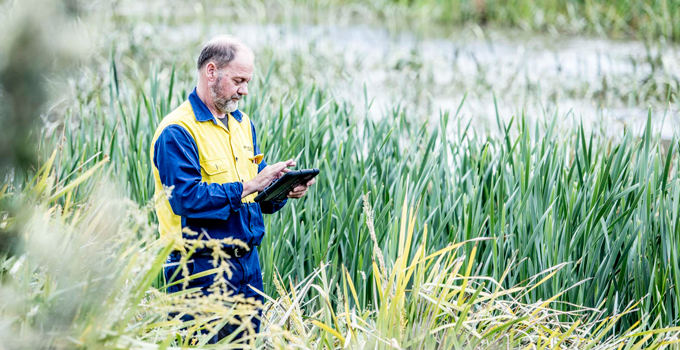
Power and water utilities can incur major penalties when natural values are insufficiently understood and poorly managed. Not only could the environment be damaged, but there could also be penalties for a compliance breach, increased costs and conditions for construction and operation, significant remediation costs, project disruption and delays, and delivery overruns.
On top of all of this, there’s no doubt that poor environmental management will damage your corporate reputation and reduce your level of acceptance by and engagement with the community and stakeholders, both at and potentially far beyond the local area.
Power and water asset owners and developers manage or have influence over large areas of natural assets. These environments often include flora and fauna on land and in waterways that are listed as threatened under state and national environmental legislation and/or international agreements.
A land manager or owner with a strong environmental management system will know and proactively manage these values. However, in many areas there is a lack of knowledge of natural values, which are consequently not included in an environmental management framework. These values are therefore at risk of adverse effects from operational decisions.
So what can you do to make sure you have a handle on your environmental risks?
Find out what you’ve got
A thorough review of available information will help you better understand the values you need to manage.
This means using existing data-sets and reports to understand the current knowledge base and identify any gaps. In other words, create an inventory of natural values for all your land and water assets. You will need to identify the flora, fauna and ecological community values on your land and in your waterways and lakes, and record their condition and their status.
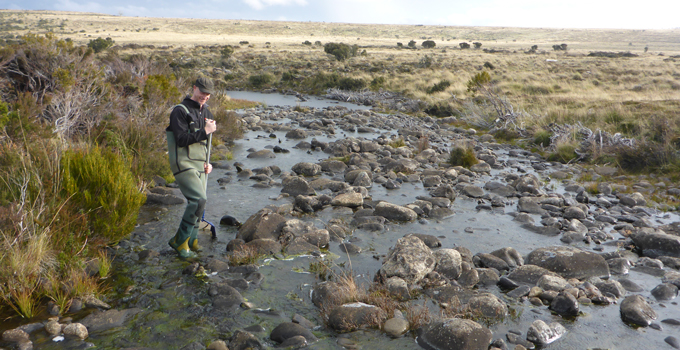
To understand the social values associated with your assets, you may also need to engage with other stakeholders and local communities to understand how they value and use your natural assets (e.g. fisheries, recreational users, water supply, transportation), as this will also influence management.
Incorporating the data into a spatial database accessible to everyone in the business will allow easy searching for flora and fauna values that may be affected by maintenance activities or new projects and ensure that relevant information about your natural assets is readily available for managers and field staff. However, this phase only identifies issues, and the degree of impact of a proposed management action on flora and fauna values is likely to require further interpretation by an ecologist.
If gaps are detected in the data or there is doubt about accuracy, field surveys can identify and verify natural values and record their condition. For example, vegetation and /or habitats have often been mapped from aerial photos and not verified in the field, so errors can arise in the attribution of a vegetation community or habitat type.
Understand your compliance requirements
Once you know what’s on your land or in your water, you can identify the potential regulatory and compliance issues.
Are there threatened species or communities listed under state or national legislation or international agreements? Are there weed or pest species or communities that have legislative requirements? Does analysis of existing water quality data highlight any trends that may affect values within the water-body or downstream (e.g. increased nutrient loading)?
If you already know what natural values you have on your land or water, you’ll be in a much better position to respond effectively to any legislative changes. You may even be ahead of the game!
Identify potential risks and their significance
Identifying and understanding risks to natural values under current and future operational scenarios is critical to successful and proactive environmental management. This requires some ‘big picture’ thinking in which the whole landscape, both terrestrial and aquatic, is considered.
A big-picture approach focuses on risks to ecological communities or functional ecosystems (e.g. wetland, lake or river) rather than extrapolating from localised information that may not reflect the broader risks. For example, to manage species at a habitat level rather than at site level, you need to identify and map habitat for threatened species across your natural assets as well as assess habitat quality.
In another example, a big-picture approach to water quality would involve having an understanding of the natural range of parameters at the local catchment scale, which may be different to recommendations in national water quality guidelines due to natural local conditions (such as the relatively low pH of tannic water bodies in peatland landscapes).

Many project risks can be mitigated if they are properly anticipated early and managed throughout the life of the project, minimising corporate, technical, environmental and social impacts and their associated costs. Having a comprehensive inventory of your natural assets will allow any threatened species or important ecological communities to be identified early in the planning phase for upgrades of existing assets or new projects. This will make the difference in understanding the effort required to avoid or minimise impacts.
The planning process is likely to be expedited because you will already know what your potential environmental impacts are and will have accounted for them in your project design, planning approval documentation and operational management plan.
This informed management approach also applies to maintenance programs, particularly weed and vegetation management, on easements and around assets. If you know where your high-value natural assets are, they can be accounted for in the maintenance program so that they will be protected.
Develop management approaches
Knowing which natural values require active management and which values may be best left alone is another key factor for successful environmental management.
Some natural values may be protected by default because they are associated with assets that are not accessible to the public (e.g. remote assets or those closed to the public because of safety risks). These natural values, particularly in intact remote wild areas, may be best managed by being left alone without any management intervention because they are not under pressure from human activities.
Other natural values may need active management and protection because they are under threat from human activities, introduced species or diseases. In this case, you need to consider the potential issues and consequences, plus the likelihood of them occurring, to evaluate the potential risk and significance of the issue.
Where the risk level is considered to be high, identify how the risk can be mitigated (e.g. restricting public access to a sensitive area while directing access to another less-sensitive area). Potential mitigation measures are generally best identified in consultation with other stakeholders, including user groups and the local community, to ensure that the measures are supported and endorsed by the community for greater success.
For example, an important conservation site such as a lake that supports threatened fish as well as recreational fish species will require a management approach supported by the angling community. That might mean developing hardened access points (e.g. tracks and boat ramps) in less-sensitive areas supported by anglers. Otherwise anglers will continue to develop their own access points, degrading lakeside habitats and potentially affecting important breeding or foraging habitat for threatened species.
Identify opportunities
If you proactively identify and manage the environmental values for which you are responsible, you may even stand to reap a range of extra benefits. You may identify natural values with potential economic and environmental value beyond the obvious.
For example, native vegetation in good condition on your land could be used to offset the loss of native vegetation associated with other projects you undertake. Or, possibly, land in good condition could be made available to other proponents for purchase as offsets for their projects. These hidden opportunities could be very valuable and make a major difference to project viability.
If you can make structured and systematic efforts to manage environmental issues proactively, you are far more likely to achieve environmental sustainability, as well as pave the way for project success, social licence and a positive reputation. For power and water asset developers and utilities, a genuine commitment and responsible approach to achieving greater operational sustainability is increasingly recognised as a key marker of success and corporate reputation.
Don’t wait. Act now to understand and manage your environmental risks.
If you would like to discuss how Entura can assist you with minimising risks and increasing sustainability, please contact Ray Brereton on +61 417 336 407.
About the author
Dr Eleni Taylor-Wood is Entura’s Principal Consultant, Environmental and Social Science. Eleni has 20 years’ experience successfully managing large-scale, complex projects, as well as providing expert advice and independent review for a range of infrastructure and planning projects. She has worked on projects around the world including in Australia, Mozambique, South Africa, Iceland, Colombia, India, Malaysia, China, Solomon Islands, Fiji and Papua New Guinea. Her experience includes environmental and social impact assessment and management, strategic management of wetlands and waterways, feasibility and approvals for new hydropower projects, environmental flow determination and assessment, and sustainability assessments. Eleni is currently one of eleven accredited assessors worldwide under the Hydropower Sustainability Assessment Protocol.
Raymond Brereton is a senior ecologist with 30 years’ experience in the field of fauna and flora survey and management. He has been involved in assessing the impacts of development on flora and fauna and their habitats, as well as providing advice on the development and implementation of policy and prescriptions for fauna and flora management across south-eastern Australia (Queensland, New South Wales, Victoria, South Australia and Tasmania). Raymond has a high level of technical expertise in the assessment and the management of threatened species and communities in both terrestrial and aquatic ecosystems in compliance with regulatory requirements
MORE THOUGHT LEADERSHIP ARTICLES
Can the sedimentation problem be solved?
Sedimentation is a problem for water storages, particularly in Asia. It is a major concern for all communities and industries that depend on water storages for water, food and energy security.

As sediment builds up over time, the storage capacity of a water reservoir will reduce. If we can effectively prevent, manage and reduce sedimentation, more water can be stored, which is critical for a sustainable future in a world experiencing increasing population, industry and climate pressures.
Loss of storage is certainly damaging to the performance of hydropower schemes, but it’s not the only sedimentation-related problem for hydropower developers and operators. High levels of sediment, whether in storages or flowing through run-of-river hydropower schemes, can seriously damage expensive hydro-mechanical equipment, causing significant operations and maintenance issues and costly outages.
It is clear, then, that planners, developers and operators need to consider how to minimise and mitigate sedimentation in all water storage projects, but particularly if the project is in a region that yields a large amount of sediment.
As with any problem, prevention is better than cure. Although, in some cases, prevention isn’t possible, or the problem already exists, so ‘curative’ options need to be explored.
Prevention
The best prevention of sedimentation problems begins at the source – in other words, the catchment area of the river. If we can reduce the sediment yield from the watershed, we can reduce the sedimentation issues in our reservoirs, increasing the life of the available storages. Most of the sediment that reaches a water resource project site is due to rainfall and run-off erosion and transportation of material by the river’s flow. When the sediment reaches a reservoir, it becomes trapped and builds up over time, reducing the amount of water that can be stored.
The quantity of sediment will be heavily influenced by the rate of erosion within the catchment, which depends on interactions among factors such as climate, soil, geology, topography, ground cover, land use and human activity. Some of these factors and interactions cannot be controlled, but human-related aspects affecting erosion and sediment yield can be predicted and managed through an integrated catchment management plan. Such a plan would require significant efforts to counter factors such as agriculture, mining, construction and deforestation, and include attention to revegetation and erosion prevention. Identifying and mitigating impacts in areas susceptible to the geological risk of landslides is another important part of the plan, whether this is around the reservoir rim or within the main catchment of the reservoir, as these areas of instability will affect sediment inflows.
Beyond this catchment-level reduction of sediment yield, planners and designers need to consider how to reduce the inflow of sediment into the particular reservoir, therefore maintaining the storage. Local or project-specific preventative approaches require accurately estimating the sedimentation rate during planning and design – through careful attention to measuring sediment concentration and the capacity inflow ratio – and, based on this estimate, considering building structures upstream of the main reservoir to either trap sediment or encourage sediment to bypass the reservoir. Sediment can be trapped before reaching the main reservoir with a series of weirs or ‘check dams’ upstream of the reservoir, yet these will only be effective until such time as they fill with sediment.
Intervention
The next option is to keep the sediment moving, either through the reservoir or past the reservoir, so the amount that is deposited in the reservoir is minimised. In many cases, the main transport of sediment is in flood water; thus, flood waters can be channelled past the reservoir using bypass structures, or can be allowed to pass through the dam at high velocity (known as sluicing). An important disadvantage of bypassing and sluicing of flood waters is the loss of a significant amount of water that otherwise could have been captured in the storage. As a result, it is most applicable in reservoirs with a smaller capacity in comparison to the total inflow.
Due to the very high cost of creating bypass conduits, bypassing the full length of a reservoir is rare, and would only be considered in special circumstances or where other methods are not effective. If the reservoir is located on a horseshoe bend of the river, a sediment bypass structure may be cost-effective due to its reduced length. Therefore the unique characteristics of the site need to be taken into account when developing the initial concept for the project, looking for opportunities created by the topography.
Sluicing involves discharging high flows through the dam structure during periods of high inflow to the reservoir, to allow sediment to be transported through the reservoir as rapidly as possible while minimising sedimentation. Sluicing is performed by lowering the reservoir storage prior to high-discharge sediment-laden floods. This approach requires relatively large capacity outlets to be incorporated into the dam design to enable the discharge of appropriately large flows at low reservoir levels to maintain the required velocities to transport sediment. This is achieved through low-level under-sluice gates, or tall crest gates, or both.
To understand how a reservoir will behave, appropriate investigations are needed in the planning stage to accurately determine the sediment characteristics, inflow and distribution in the reservoir. This data can then be used to model the flow and deposition of sediment within the reservoir, using sophisticated hydraulic modelling software. These models can be used to fully understand the problem, and to test solutions – helping to determine the appropriate location and capacity of low-level outlets, develop operating rules that will work for the particular reservoir, set the intake invert to avoid future problems, and develop an overall concept for the dam that works – all of which will contribute to avoiding future problems.
The sediment problem becomes particularly worrisome for run-of-river hydropower plants located in rivers which typically carry a high level of sediment, such as rivers flowing from the Himalayas. To protect against damage to equipment, desilting arrangements such as desilting tanks and chambers are generally provided, normally immediately downstream of the intake structure to the water conveyance system, whether a canal or a tunnel, along with modifications to equipment, such as coatings to better resist abrasion.
Remediation
The aim of remediation is to recover the original storage volume of the reservoir. If sediment has built up in a reservoir in the absence of, or despite, preventative measures, the options are now limited to reducing sediment levels through hydraulic methods (flushing through reservoir drawdown) or mechanical methods (excavation or dredging). The advantages of hydraulic methods are that they tend to be cheaper and easier, using water currents or flows to force sediments through gates and outlets close to the reservoir bed. Nevertheless, these methods may release large amounts of valuable water through the emptying of the reservoir, which may not be desirable during either dry conditions, or where the storage volume is very large in comparison to the annual inflow.
Mechanical methods, such as dredging and excavation, are typically very expensive and only practical on certain reservoirs, and therefore seen as a last resort. Dredging can either be via hydraulic pumps (for finer sediment) or mechanical grabs (for coarser sediment) on barges. Due to its expense, it is often only used to remove sediment from specific areas near the intake structure of a dam. If a reservoir can be completely drawn down, which is not practical for many reservoirs, accumulated sediment can be removed through scrapers or excavators and dump trucks.
Finally, there may be the potential to add new storage to the existing reservoir by raising the dam. The practicalities of this will need to be evaluated through a feasibility study process, as is normally adopted for a new dam.
The right solution depends on good information
In many cases, managing sedimentation will require a combination of strategies and technologies, such as reducing the sediment yield at the catchment level, reducing inflows of sediments into storages using appropriate structures and technologies, operating storages effectively during flood conditions, and actively managing storage levels and operating rules to allow sluicing and flushing.
Many of the sedimentation problems experienced around the world were either not predicted or significantly underestimated during design. To avoid this situation, continuous, adequate and accurate monitoring data is needed, as well as appropriate modelling and projections that take current and potential future conditions into account. Solutions that have been tested via appropriate modelling are much more likely to meet performance requirements and to avoid future risks.
The rate of sediment deposition is heavily influenced by the sediment concentration and the capacity inflow ratio, so careful estimation of these two parameters is very important in identifying the seriousness of a sedimentation problem. In existing large reservoirs, sediment management will benefit from supplementing conventional hydrographic surveys with the adoption of improved survey methods and remote-sensing techniques. The resulting data will enable more reliable estimation of sedimentation rates.
Better measurement, modelling and estimation of sediment – for existing storages as well as future reservoirs – will provide the insights we need to improve sediment planning and management. The right combination of sedimentation estimation, prevention, intervention and remediation will be critical for the long-term health of our water storages and a sustainable future.
If you would like to find out more about how Entura can help you develop a sustainable water storage solution or respond to sedimentation challenges, contact Shekhar Prince on +61 412 402 110.
About the author
Richard Herweynen is Entura’s Technical Director, Water. Richard has three decades of experience in dam and hydropower engineering, and has worked throughout the Indo-Pacific region on both dam and hydropower projects, covering all aspects including investigations, feasibility studies, detailed design, construction liaison, operation and maintenance and risk assessment for both new and existing projects. Richard has been part of a number of recent expert review panels for major water projects. He participated in the ANCOLD working group for concrete gravity dams and is the Chairman of the ICOLD technical committee on engineering activities in the planning process for water resources projects. Richard has won many engineering excellence and innovation awards (including Engineers Australia’s Professional Engineer of the Year 2012 – Tasmanian Division), and has published more than 30 technical papers on dam engineering.
MORE THOUGHT LEADERSHIP ARTICLES
Congestion and losses: more than a blocked nose for new renewable generation
Anyone who’s ever had a cold understands the discomfort of blocked airways. Congestion challenges, albeit slightly different ones, also face developers of new renewable energy generation.
The nature of powerflows around the grid is changing rapidly with a lot of new generation being built on the edges or middle of the transmission system. This is increasingly being recognised as a problem, but quantifying the impact can be tricky.
Developers are asking: “What other generation will or can be built in the area? Will there or can there be collocated storage? When may these things be built? Will other projects in the area have a similar generation pattern to my plant?” And these questions are becoming harder to answer with the wave of renewables development.
Answering these questions
There’s no real substitute for analysis and an understanding of the degree of certainty required.
A simple example of adding generation in north-east New South Wales illustrates the point. Naturally, developers think first about competition: “Will added generation displace existing generation in NSW or generation on the interconnector? What is the most conservative assumption? What is the balance of probabilities?”
Even this simple example leads to many assumptions and choices, so proponents and owners need to understand how certain they need to be – and therefore how thorough the investigation of congestion needs to be.
What other questions are there?
Traditionally, congestion has been considered a problem of network thermal capacity. The nature of renewable energy generation adds other factors into this mix, such as: “Will fault levels remain high enough to support short-circuit ratios? Will critical clearance times be maintained to allow the full thermal capacity to be used? Will imbalance of generation development on parallel paths reduce pre-contingency loading limits?”
These sorts of questions require complex analysis, adding further uncertainty and additional dimensions to the results.
There’s talk of additional network provision being required to support changes to the flows in the transmission system. Such changes will no doubt be helpful, but questions of when, how much and who pays must be asked.
We can see that calculation of congestion has real impact on expected revenues – but with so little certainty, it is hard to determine how critical any impacts may be on the overall business case.
What about losses?
The other effect of large generation on transmission flows is greater network losses. The marginal loss factor (MLF) regime that accounts for losses in the National Electricity Market (NEM) relies on many of the assumptions of congestion analysis, with similar levels of uncertainty of the input increasing the uncertainty of the output.
MLF has always appeared punitive for new renewable generation distant from the load centre, since long transmission distances (often over low-capacity lines) lead to inefficient power delivery.
The MLF regime is supposed to incentivise development of efficient and timely generation and demand. The drivers for renewable generation are less about actual demand and more about displacement, so the MLF inhibits the building of new generation in favour of the status quo. A simplistic analysis, however, shows that, on average, new renewables see slightly higher MLFs than the established generation and new thermal assets.
There could be a number of explanations for this but it shows that the density of generation has remained low enough thus far. Increased build and in-fill will ultimately lead to MLFs becoming a bigger and bigger factor for new and existing plant.
Other congestion issues
There’s another form of congestion looming or already starting to impede the rapid deployment of solar and wind technology: a lack of capacity of network service providers (NSPs) and other regulators to deal with the influx of applications for new connections.
Add to this the increasingly technical analysis required to demonstrate compliance of these connections with the rules and a real bottleneck is created.
Blow your nose
The truth is, the only answer to any congestion issue is to remove the blockage .
In terms of network congestion, in the short-term, we need to continue to think about the likely requirement for renewable developments (with storage) to meet the challenges of the energy trilemma – replacing coal-fired generation following retirements with reliable, affordable and more sustainable generation.
And we will need to better understand the value of transmission re-enforcement to support a changing generation fleet.
It may also force a return to the Hub or Scale Efficient Network Extension (SENE) type of thinking that gives a clear signal to proponents to ‘build here’, as we can now see in New South Wales.
Network re-enforcement may also improve MLFs, slightly. However, if MLFs are low across the board in a region, the pool price will adjust to reflect this over time. In the short term, local or regional storage may be cost-effective in raising MLFs to investment-tolerable levels.
In terms of resource issues, training and applying more skilled resources to this sector must be a focus for NSPs and regulators.
Our approach as consultants is to not always recommend more analysis but, alternatively, the right and the most efficient form of analysis.
The challenge for NSPs and regulators is to act more commercially and embrace an engineering approach to analysis, tolerating some uncertainty – just as proponents do.
We always feel better once the fog of congestion lifts. Sometimes we try to fight through it, but it’s often better to take deliberate action to treat it and to avoid complications, just as when you are suffering the symptoms of a cold.
If you would like to find out more about how Entura can help you navigate network challenges, please contact Donald Vaughan on +61 3 6245 4279.
About the author
Donald Vaughan is Entura’s Technical Director, Power. He has more than 25 years of experience providing advice on regulatory and technical requirements for generators, substations and transmission systems. Donald specialises in the performance of power systems. His experience with generating units, governors and excitation systems provides a helpful perspective on how the physical electrical network behaves and how it can support the transition to a high renewables environment.
MORE THOUGHT LEADERSHIP ARTICLES
Hybrid renewables deliver sustainable, reliable power for Rottnest Island
Whether on-grid or off-grid, hybrid renewable energy systems offer exciting potential for achieving a sustainable and reliable power supply.

The specific drivers for each hybrid renewable development and the particular configuration of technologies will vary depending on the circumstance – yet, the common factor is applying supportive technologies to maximise the use of renewable energy and stabilise the resulting power system.
In many off-grid projects, the main goal may be to displace diesel generation. Renewables offer a free and often abundant fuel source with low or no emissions, but the challenge is ensuring these weather-dependent resources are available when needed.
The relative impact of the variable nature of renewable energy is greatest in off-grid applications. As the proportion of renewable energy increases, so does the need to carefully manage the wider power system by incorporating technologies such as batteries, flywheels, diesel generators, feeders and auxiliary systems to enable, control, integrate and support the variable renewable energy sources without compromising the security or reliability of the power system.
The Rottnest Island Water and Renewable Energy Nexus (WREN) project offers an inspiring example of how innovative deployment of hybrid renewables can increase the power supply security and sustainability of an off-grid island and drive water desalination.
A roadmap to renewables
Rottnest Island is a nature reserve and major tourist attraction about 20 kilometres off the West Australian coast, near Fremantle. This island’s management authority, residents and visitors have long desired a more sustainable way to power its needs, not only for electricity but also for water, while protecting its precious and delicate environmental values.
Until the late 1970s, diesel generation was the only source of electricity on the island – an expensive and not environmentally friendly option. Early-development wind turbines began limiting diesel use, but it wasn’t until 2004 that a 600 kilowatt wind-diesel hybrid system was installed – generating about a third of Rottnest’s energy and saving about 400 000 litres of diesel each year.
That was a start, but there was still a long way to go towards a more sustainable, reliable and affordable power system. The WREN project was conceptualised by Hydro Tasmania and Entura after working with the Rottnest Island Authority to develop a roadmap for increasing energy efficiency and renewable energy. The roadmap presents a staged plan to increase the renewable energy contribution with times of 100% renewable supply in the future.
Designing the WREN
The WREN project integrates solar, wind and diesel, supported by a dynamic resistor, which smooths fluctuations in the availability of the renewable energy sources. The wind, solar and diesel generators are regulated by a hybrid power system controller that coordinates and dispatches the generation and demand-side management. It also manages the enabling technologies automatically to ensure reliable power and maximum savings of diesel fuel. But that’s not all. What makes the project a ‘water and energy nexus’ is that it incorporates management of the intensive power demands of the island’s water desalination plant.
The desalination plant is automatically controlled from the power station to operate when the renewables are abundant, rather than ‘wasting’ any excess renewable energy (available during sunny or windy periods when renewable generation exceeds customer needs). In effect, storing surplus renewable energy as water acts like a ‘water battery’.
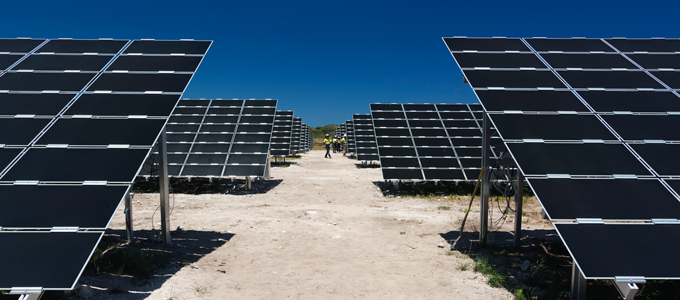
The WREN project uses any available surplus renewable energy not only to run the desalination plant, but also to provide useful ancillary services, resulting in a higher quality and more reliable power supply. High power quality is maintained by quickly and accurately balancing supply and demand. Surplus energy is converted into fast-acting reserve within the dynamic resistor through rapidly loading and unloading the resistor elements. This means that the system can achieve and maintain a higher level of renewable penetration over a wider range of conditions.
The dynamic resistor greatly improves the security of the system by supporting the low-load diesel engines to operate at a minimum loading of only 5%, compared with 30% for standard high-speed diesel generators. It does this by absorbing rapid increases in renewable generation that would otherwise result in a reverse power trip of the generators.
With the increased sophistication of the Rottnest power system, the existing equipment controllers were unable to effectively integrate control information, as that information couldn’t be provided at the required resolution or speed. The hybrid controller was able to integrate directly with industry-standard diesel controllers and newly installed power meters to overcome these issues.
Powering a sustainable energy future
The WREN project’s combination of managing demand and providing ancillary services via the dynamic resistor and other enabling technologies creates a cost-effective way of reducing reliance on diesel fuel without needing to rely on capital-intensive battery systems. The project required coordination of protection and control for a reliable, firm power supply.
The result of integrating all these technologies and measures is that Rottnest Island is now almost 45% powered by renewables, and up to 95% at times of high wind and solar generation. This means lower costs and less emissions, and a far more secure future for the island’s power and drinking water – which are critical to maintaining tourism.
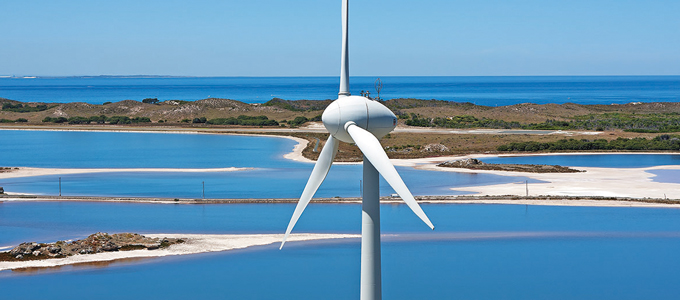
The WREN project takes the tourist experience one important step further: educating tourists about power and water sustainability through digital educational materials that allow real-time interaction with the cutting-edge power/water system, delivered via mobile apps.
The success of the WREN project has obvious application for remote, off-grid or island communities worldwide – but the strength of the technologies and their integration and control are equally applicable to the creation of ‘dispatchable’ renewables at any scale.
If you would like to discuss how Entura can support your hybrid renewables journey, please contact Patrick Pease or Shekhar Prince on +61 412 402 110.
About the author
Seth Langford is a specialist renewable energy engineer at Entura and has been working in the renewable energy industry for more than ten years. Seth has been involved with major hybrid renewables and wind power projects as a technical specialist and a team leader for feasibility studies and due diligence projects in Australia, India, China, , Sri Lanka, South Africa and New Zealand.
MORE THOUGHT LEADERSHIP ARTICLES
Winning over your solar farm community
Effective engagement can reduce community opposition to a solar farm, but, better yet, it has the potential to create a level of community support that results in locals themselves promoting it.

Regardless of the technology, any large-scale renewable energy project will attract attention from its nearby communities. Without a ‘social licence’ to operate, the project may face significant hurdles including negative publicity, public protest, litigation or even cancellation of permits.
Engaging with the host community early in the development stages is key to a successful project and developers may be required to demonstrate that they have done so, even before submitting a permit application. This will help assure authorities (and potential buyers) that the project has support.
These are our top community engagement tips for developers to ‘keep the sun shining’ on a large-scale solar project.
Know your community
Despite the exponential rate of increase in large-scale solar installations in recent years, it is still a relatively new technology. While some community members may be quite knowledgeable about renewable energy technology, others may know little.
Each person will have different attitudes and expectations of a solar farm, and engagement should include all stakeholders in the community to make sure nobody is left out of the conversation. Someone living close to the solar farm may be interested in how it will affect the value of their property or if PV panels will reflect light in the direction of their home. A business owner in town may be interested in employment opportunities or how construction will affect local roads. An obvious question for everyone is whether the project will lead to cheaper electricity!
A developer, owner or operator should identify and meet as many different stakeholders in the community as possible to get to know their individual interests and needs.
Design a relevant engagement program
A comprehensive engagement program must communicate accurate project information, set realistic expectations, listen to the community, incorporate feedback into project design, and find opportunities for the solar farm to ‘give back’ to the community in some way.
Well-planned projects need engagement strategies designed specifically for the community in which the project is located. Using a ‘one-size-fits-all’ approach won’t cater for the unique circumstances of each community.
To inform the choice of engagement methodologies and tools, developers should consider the size, interests and skills of the local and regional community, the number of neighbours, who the local influencers are, and what other energy developments are present in the region.
Methods to engage with different stakeholder groups will vary depending on the stage of the solar farm’s development and the objective of the engagement process at that stage. Engagement practitioners use a range of different communication tools, from more traditional techniques to social media, from ‘kitchen table’ meetings to reference groups and focus groups.
Communicate realistic expectations
Large-scale solar farms are generally less controversial than wind farms or hydropower projects due to the relatively low physical impact they have on communities and the local environment. However, there may still be questions and concerns in the community, especially for communities in remote and rural locations where there may not be any other large infrastructure.
Throwing scientific facts and figures at people to convince them of benefits or mitigate fears will not necessarily help concerned locals feel any more confident about a project. Anecdotal negative information can be readily found on the internet to undermine confidence, and some community members may distrust the intentions of developers from large corporations.
The task of building the community’s confidence in a project is therefore an important yet sometimes difficult activity. The best approach is to communicate any foreseeable short-term and long-term impacts as early as possible and in an open and non-defensive manner before the community dwells on the risks. Listening to the community and working together to identify social and environmental risks will help build trust between the project team and stakeholders.
Build trust and confidence
Genuine community engagement is not ‘spin’. It’s about building an open and ongoing relationship with local stakeholders. The more work that is put into building healthy relationships and trust, the stronger the foundation for achieving a social licence to operate.
As communities generally become more familiar with large-scale solar technology, there will likely be a shift towards greater community acceptance of solar projects. Until then, developers need to recognise the community’s interest in a project and take responsibility for explaining solar technology and identifying risks for the community.
Local stakeholders should be told about a project prior to applying for permits. By engaging early, the developer will have time to explain how solar technology works, outline the construction process, and conduct a social risk assessment. Preferably engagement should be face-to-face and consistent. People are far more likely to accept projects when they feel that they have been included, heard and respected.
Obtain a ‘social licence’, but don’t stop there
Obtaining a social licence to operate is essential. It can mean the solar farm and its owner are talked about positively in the region and the project encounters few hurdles. But obtaining a social licence is not the end of the journey. A social licence must be maintained throughout the project’s lifecycle.
Owners and operators can maintain a social licence through ongoing and regular communication with the local community and other key stakeholders. Communication should be two-way and communities should know how to easily provide feedback that is treated confidentially. Stakeholders should also trust that their concerns about the solar farm will be recorded and responded to in a timely manner. Evaluating and reporting on feedback will also help to promote a transparent and constructive process.
If you would like to find out more about how Entura can help you engage successfully with your solar farm project’s community, contact Silke Schwartz on +61 407 886 872 or Patrick Pease.
MORE THOUGHT LEADERSHIP ARTICLES
Identifying Australia’s best sites for pumped hydro development
There are many thousands of potential sites for pumped hydro energy storage developments across Australia, but how can a developer filter these down to the best few?

As Australia’s energy market progressively transitions from ageing thermal generation to increasing amounts of wind and solar, there are ample chances to explore and develop the energy storage solutions needed to mitigate the challenges that may come with the introduction of more renewables into the energy market.
With increased intermittent renewables, we will require more storage to smooth out the variability of weather-dependent generation so that energy is available on demand. As well, we will need storage that provides the inertia, voltage and frequency control required for a stable, reliable grid.
The key to successfully embracing these energy storage opportunities will lie in identifying the right mix of technology, capacity and site; however, pinpointing potentially viable projects is complex. A theoretical or academic approach won’t be enough to ensure a future project’s success in the real world.
Pumped hydro is a highly efficient, longer-duration solution with a proven track record, and its future is bright as Australia seeks cost-effective, reliable options to make intermittent renewables ‘dispatchable’.
There are thousands of potential pumped hydro sites across Australia. This means that developers and investors need smart methods of filtering to reduce the many possibilities to just a few ideal sites.
A pumped hydro project is a major capital investment. Getting site selection right is the foundation for success, as it will determine the likelihood of achieving a design that is both technically and commercially feasible with the right mix of capacity and costs.
Pumped Hydro Atlas of Australia offers a head start in site selection
Entura has produced a practical atlas of pumped hydro energy storage opportunities to support development of dispatchable renewable energy generation across Australia’s National Electricity Market (NEM).
Through an exhaustive process, the atlas filtered many thousands of potential sites down to the best 20 around Australia. It is already being used by leading renewable energy company Hydro Tasmania to shortlist potential pumped hydro sites for the ‘Battery of the Nation’ initiative (a major Tasmanian initiative looking at how Tasmania could deliver more clean, reliable and cost competitive energy to Australia’s NEM). Identification of promising pumped hydro sites through the atlas also offers opportunities for developers in states such as South Australia and Queensland, which have set ambitious renewables targets and must maintain energy security.
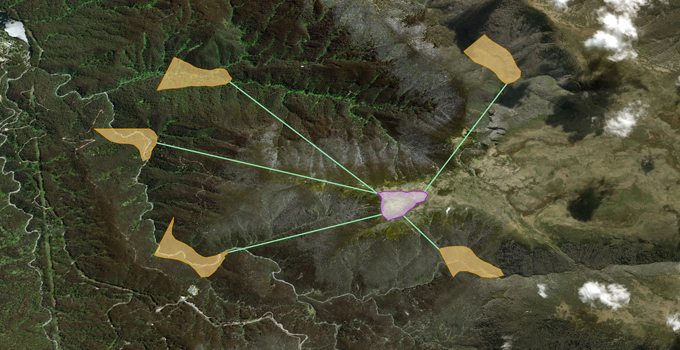
Entura’s Pumped Hydro Atlas of Australia takes into account far more than the basics of identifying ideal topography and a source of water. It also accounts for other practical factors that can make or break a project: such as proximity to and location within the transmission network, land-use constraints and environmental risks, and the practicalities and costs of construction and ongoing operation. This makes it a real-world, relevant resource identifying the best sites for pumped storage projects across the NEM.
Developing the Pumped Hydro Atlas of Australia
Originally commissioned by Hydro Tasmania, the Pumped Hydro Atlas of Australia was completed in October 2017. The journey began with a literature review, appraising previous studies. This informed the development of a set of rules, assumptions and algorithms for a GIS-based study of different reservoir types and pairing mechanisms, which were tested on pilot sites.
Using these algorithms, more than 200 000 pairing reservoirs were identified across the NEM states (Queensland, New South Wales, Victoria, Tasmania, South Australia and the Australian Capital Territory). State-based heat maps of potential sites for pumped hydro development were prepared, along with a summary of all key characteristics for each pairing reservoir set, such as installed capacity, energy storage, distance from the nearest substation, gross head, approximate headloss in the waterways, and active reservoir volume.
A subsequent stage of refinement prioritised high-potential sites in some states. This process took into account greater practical detail, such as costings, practical engineering aspects, environmental approvals and risks, realistic high-level arrangements, proximity to other generators, and characteristics of hydrology and energy storage. This stage identified more than 5000 unique potential sites, which were then further refined with a set of rules to select the best pairing reservoir at each site. The approximately 5000 sites were reduced to approximately 500 of the most attractive options: those with an average head of more than 300 m with relatively short distances between the reservoirs.
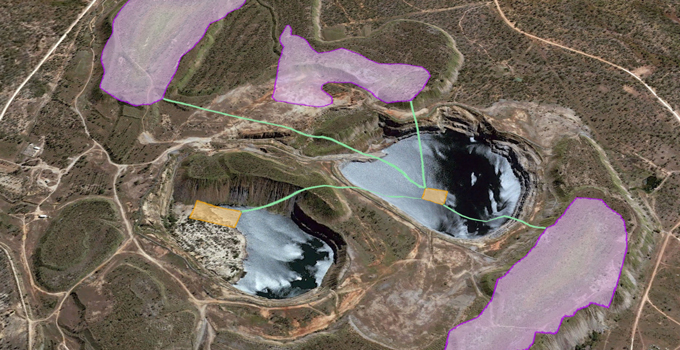
This exhaustive refining process ultimately resulted in a shortlist of twenty promising sites across different states, with a desktop review of geology, high-level engineering arrangements, and approvals requirements. For each site a map was prepared including locality, land use, planning zones, and key characteristics of the potential pumped hydro project.
The Pumped Hydro Atlas of Australia is an example of how applied hydropower engineering can be used to create practical outputs, which are ready to be applied in the real world. Overlaying the outputs of this atlas with any new wind and solar development across the NEM could result in opportunities to invest in dispatchable renewable energy generation hubs capable of replacing thermal generation assets as they retire.
Pumped hydro energy storage will no doubt play a major role in the development and expansion of networks powered by renewable energy – in Australia and around the world. As Australia’s electricity mix evolves, so will the economics of storage. While forecasting revenue for storage projects in the Australian electricity market is still somewhat uncertain, there are many opportunities in both the existing and emerging markets to guarantee project revenues to a level sufficient to satisfy a lender’s requirements. The opportunity for investors seeking a head start in this emerging market is now.
If you would like to discuss how Entura can help you with your pumped hydro or renewable energy project, please contact Richard Herweynen on +61 429 705 127 or Phillip Ellerton on +61 439 010 172.
MORE THOUGHT LEADERSHIP ARTICLES
Tackling renewable energy integration: five lessons from Sri Lanka
Ambitious renewables targets, movements away from thermal generation, increasing demand for electricity … it’s boom time for renewables around the world. Yet the global energy transformation brings some challenges, particularly for network stability and security.
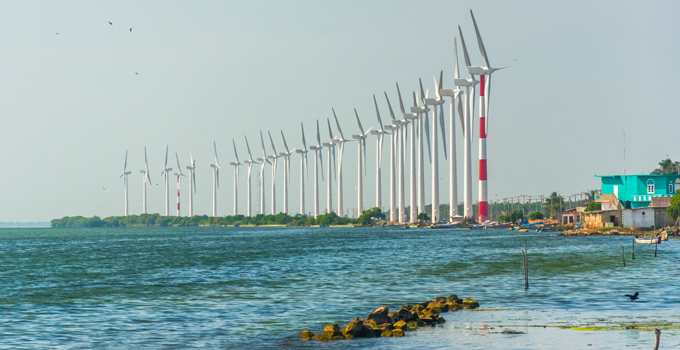
Sri Lanka offers an interesting case study in the complexities of quickly integrating a large proportion of renewables and how some of the hurdles may be overcome. The lessons we can learn from the Sri Lankan experience are applicable worldwide.
In 2016 the government of Sri Lanka set a very ambitious renewable penetration target, with 100% of power generation to come from renewable sources by 2050. Coal and oil generation, currently accounting for around 50% of all generation, will cease by 2045. If this isn’t challenge enough, add in the projection of maximum demand rising above 7000 MW (from a current daily maximum of 2500 MW) by 2040.
Between September 2015 and March 2016, three nation-wide blackouts threatened to significantly undermine Sri Lankan industry and foreign investment prospects. The challenge for the Ceylon Electricity Board (CEB, which runs Sri Lanka’s power system) now is to achieve the country’s power transformation while still ensuring network security and reliable electricity. Any future unexpected system outage would be likely to erode public confidence in renewable development, regardless of whether the outage relates to renewables or not.
What can we learn from the Sri Lankan experience of the 2015/16 blackouts and Sri Lanka’s current challenges in its journey to a renewable energy future?
1 – Focus on accurate modelling of the power system
The first lesson to be taken from the 2015/16 blackouts is the need to focus on power system modelling. The first blackout occurred after a trip of the largest generating plant under light load. The next was due to a trip of a major transmission line when two parallel circuits were taken offline for maintenance. Neither of these events were envisaged through system model simulations. If a utility’s simulation tools won’t predict such events, planning engineers will struggle to anticipate or guarantee system security under system contingencies.
For system planning and operations, CEB has developed a power system model consisting of major hydropower, oil, coal and wind plants. However, no model accuracy requirements are specified in the national grid code, which leads to the use of generic models with unknown modelling accuracy. Prior to Sri Lanka’s 2015 blackouts, limited tests were conducted to tune the models to accurately represent behaviour. During 2017, CEB embarked on a project to test the model validation for at least some of the major hydro units. These tests need to extend to all major power plants so that engineers can trust the actual performance of every major generator in the system.
2 – Determine a clear, single responsibility for the system model
The second lesson from Sri Lanka’s system modelling is the need for a single owner of the system model files, with responsibility to maintain the model and ensure its accuracy. If different departments of a utility have different system models, results of an event analysis may vary.
Ideally, the entire power system should be modelled accurately and the model controlled by a single team. This is vital for maintaining integrity of the system studies conducted by various parties.
3 – Consider minimum generation
When making decisions about the size of power plants, it is quite common for the focus to be on maximum generation. However, to minimise any unwanted constraints, it is really important to consider the lowest level of generation at which the plant can operate.
Three coal plants in Sri Lanka each have capacity of 300 MW with minimum generation of 180 MW. During periods of low demand, all three coal plants need to remain at their minimum of 540 MW (3 x 180 MW) even if other generation is available in the system.
4 – Ensure the network code looks to the future
When determining the grid code, it is essential to keep an eye on the development of non-conventional renewables. The grid code needs to be able to manage power quality issues in the future while minimising unnecessary costs to developers. In other words, it must have enough regulatory power to impose required technical targets, yet be flexible enough to minimise unnecessary mandatory capital expenses.
5 – Set up an ancillary service market
Sri Lanka does not currently have an ancillary service market, so the fall-back position is mandatory interruption to the system load under certain contingencies. This will not be acceptable in the longer term and customers will demand higher reliability. A way of categorising system support, especially frequency control ancillary services, will enable CEB to maintain system reliability as well as understand the quantities and price to deliver the required reliability.
Some tightening of Sri Lanka’s current technical and connection policies and practices will be needed as the country embarks on drastic change in its generation mix in pursuit of its renewables target. Yet the lessons we’ve explored in this article are readily applicable to any network keen to accelerate substantial integration of renewables, especially solar PV and wind, for a successful energy transformation and a future of reliable and sustainable power.
If you would like to find out more about how Entura can help you overcome network challenges when integrating renewables, please contact Ranjith Perera on +61 3 6245 4272, Shekhar Prince on +61 412 402 110 or Patrick Pease.
About the author
Ranjith Perera is a Specialist Power Systems Engineer at Entura. He has over 22 years of experience in Australia and South-East Asia, working on customer and generation connections and broader power system analysis. Ranjith has provided power system advice on a wide range of network augmentations, network planning and system stability in Australia and internationally. These studies included option analysis in transmission planning, constraint analysis, determination of reactive support (dynamic or static) in system stability / TOV and detail load modelling in voltage stability. Ranjith also developed voltage recovery guidelines to TNSP based on regulatory requirement and customer equipment tolerances.
MORE THOUGHT LEADERSHIP ARTICLES
Dispatchable renewables: a contradiction in terms?
As Australia replaces retiring coal generation with renewables, can we achieve an energy future that is affordable and sustainable as well as reliable?

The role of renewable energy in achieving affordability and sustainability is clear. As coal-fired power stations approach retirement in Australia, renewable generation from wind and solar PV appear to be the most cost-effective options for new energy generation. Wind and solar power now offer the lowest cost of energy, have low ongoing operational costs, and emit the least greenhouse gases across their lifecycle – and therefore hold the greatest potential for rapid decarbonisation of the energy sector.
But what about achieving the third element in what has been termed the ‘energy trilemma’: reliability?
Replacing coal-fired power stations with wind and solar PV is not a like-for-like swap in terms of availability of power when it is needed by consumers. Coal-fired power stations produce firm baseload power, but generation from renewable resources varies due to the availability of the natural resource. Wind and solar PV power vary according to the weather and the time of day, and even if we consider new hydropower opportunities, most of these are small ‘run-of-river’ systems, the output of which varies with rainfall and the inflows to rivers.
Yes, these renewables certainly produce energy, but is the power produced when it is needed?
The variability in power from renewables makes matching supply and demand a challenge. This challenge increases as more renewables enter the market. With moderate amounts of renewables, it is still possible to maintain system reliability through clever solutions – in particular, targeted grid support designed through careful planning and study of generation profiles, and supported by solid communications, control, power systems studies and forecasting. However, there is a limit to such approaches, and ultimately Australia will need ‘dispatchable renewables’ in the energy mix to achieve all the elements of the energy trilemma – in other words, renewable generation that is available whenever consumers require it. The time to start planning for this transition is now.

For generation to be dispatchable it needs to be available at the request of power grid operators or the plant owner according to the needs of the market. Dispatchable generators can be turned on or off, or can adjust their power output according to market need. If a generator is dispatchable it can be used to match load, meet peak demands, or fill the gap if another generator suddenly goes offline. Dispatchable generation is very valuable to the market because it can be used to match the profile of energy demand.
Effectively, baseload fossil fuel generation can be replaced by the combination of variable renewables, dispatchable renewables, smart high-voltage network support and planning to ensure sufficient transmission capacity, and change in use of existing hydropower.
How can we make variable renewables ‘dispatchable’?
The concept of dispatchable renewables seems almost contradictory: how can something generated from an inherently variable resource be dispatchable? There are two parts to this: the first is to look at how well different wind and solar PV sites naturally work together to firm supply (i.e. how likely it is that dips in one source are filled by peaks in another). Once this is understood, we need to consider how much storage is required to manage residual variability. Storage is critical here as it provides flexibility to store excess or low-value energy for times when it is really in demand.
When patterns of renewable generation are highly correlated (in other words, the timing of generation is very similar), more storage is required. For example, if the east coast of Australia develops a very high proportion of solar PV generation capacity, then all of these will be generating within about two hours of each other during the day (because of similar sunrise and sunset times across this region), and not at night. To fully utilise this energy, much of it would need to be made ‘dispatchable’ by adding substantial storage for the night-time hours, or we would need to firm the supply using another generation source, such as a gas turbine. But with a suitable proportion of wind in the mix (and stronger interconnectors to solar generation from other regions), the same dispatchability can be achieved with a more moderate amount of storage. This example demonstrates the importance of achieving a mix of renewable generators to meet the goal of dispatchability.
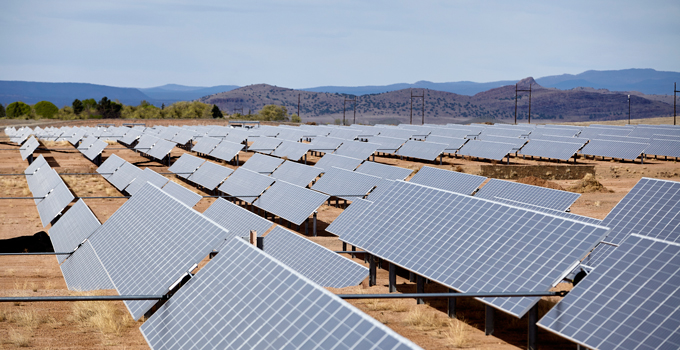
Various studies of generation in the NEM over time have demonstrated that wind and solar generation are not highly correlated. These studies have shown that even with low to moderate correlation, when considered over a large geographical area, a combination of such generators reduces variability and increases reliability of supply. Understanding this effect enables appropriate sizing of storage to create a dispatchable renewable portfolio with maximum value. There will always be some times when multiple generators produce near maximums, as well as some times when both wind and solar produce near minimums; these occasions are not common, but could have significant consequences. This is a risk that needs to be managed by the system.
The amount of firm capacity can be increased by over-installing generation, and curtailing its output when there is too much generation. However, there are still those infrequent periods when multiple generators are at their minimum and parts of the grid need extra support. Having this support available during these rare occasions will be critical to managing risk and maintaining reliable supply.
This indicates that the mixture of different renewables won’t take us all the way to the goal of achieving ‘dispatchable renewables’; storage remains a critical ingredient.
What’s the future for energy storage?
The media is awash with reports of new energy storage options. It is important to recognise, though, that different types of storage solutions vary widely in their ability to discharge power over different time frames. Therefore one type of storage will not necessarily deliver the same solution as another type of storage. Understanding this is critical to the concept of dispatchable renewables.
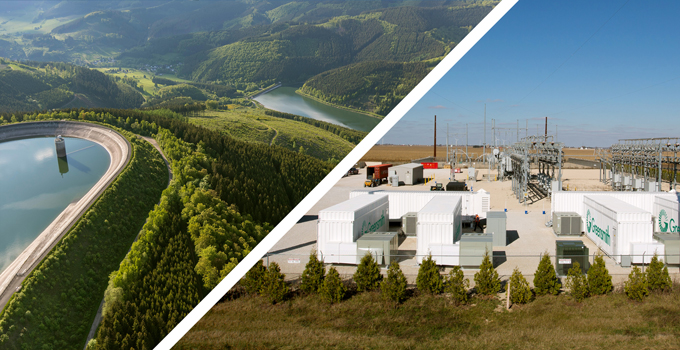
The power and duration of the storage are the two key variables in determining the most suitable solution. Low-power, short-term storage is currently more cost-effective using batteries, but longer periods and larger power requirements are likely to rely on bigger storage options, such as pumped hydro energy storage and traditional hydropower.
With individual wind and solar plants pushing 1 GW, pumped hydro and modified traditional hydropower solutions need to be considered. Smoothing out the daily variability in renewables can be achieved effectively through pumped hydro, but multi-day storage to supplement periods of extreme events of both low wind and low solar will require traditional hydropower with very large reservoirs.
In the long run, short-term storage will not be sufficient alone to achieve the aim of ‘dispatchable renewables’. Achieving full dispatchability of combined wind and solar PV power will depend on utilising pumped hydro storage and existing hydropower storages to their full potential.
When will we need dispatchable renewables?
The question of when we’ll need dispatchable renewables is complex. It’s driven by a combination of commercial, regulatory and technical considerations as well as changing customer behaviour (all of which are in motion).
The short answer is now.
There are already isolated opportunities in which dispatchable renewables offer distinct advantages, and where the business case may stack up. With increasing wind and solar PV developments in the network without dispatchable capability, such opportunities will only expand. However, the lead time required to include large-scale storage in these ‘dispatchable renewables’ projects means that planning must begin well in advance.
If you would like to discuss how Entura can help you explore potential opportunities for dispatchable renewables, please contact Phillip Ellerton on +61 439 010 172, Richard Herweynen on +61 3 6245 4130 or Chris Blanksby on +61 408 536 625.
About the authors
Richard Herweynen is Entura’s Technical Director, Water. Richard has three decades of experience in dam and hydropower engineering, and has worked throughout the Indo-Pacific region on both dam and hydropower projects, covering all aspects including investigations, feasibility studies, detailed design, construction liaison, operation and maintenance and risk assessment for both new and existing projects. Richard has been part of a number of recent expert review panels for major water projects. He participated in the ANCOLD working group for concrete gravity dams and is the Chairman of the ICOLD technical committee on engineering activities in the planning process for water resources projects. Richard has won many engineering excellence and innovation awards (including Engineers Australia’s Professional Engineer of the Year 2012 – Tasmanian Division), and has published more than 30 technical papers on dam engineering.
Dr Chris Blanksby is a Specialist Renewable Energy Engineer at Entura, and Entura’s lead solar energy specialist. He has undertaken and published research on the solar resource in Australia, and has led several due diligence and owner’s engineer projects for wind, solar and microgrid projects in Australia, the Pacific and Asia.
MORE THOUGHT LEADERSHIP ARTICLES
Six steps to reduce risks when investing in renewable energy projects
Big investments require confidence – however, caution in unlocking funds is perfectly reasonable. A thorough due diligence is the key to building investment confidence by identifying and quantifying the project’s risks, costs and benefits.
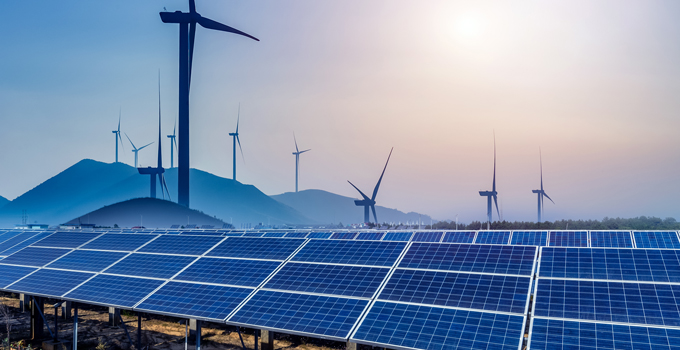
Due diligence is a broad term, and consists of technical, legal and commercial considerations. In practice, it means developing a full understanding of the proposed project, discovering any risks that could prevent its success, and capitalising on the project’s strengths. Not all risks will be ‘show stoppers’, but identifying any potential risks, judging the likelihood and impact of those risks, and identifying mitigations will enable greater confidence that the project is a viable investment.
Whatever the renewable energy project – a solar farm, wind farm, hydro scheme, hybrid solution, pumped hydro energy storage facility or other emerging option – technical due diligence considerations need to explore total energy yield, project uncertainties, technology choices, social and environmental implications, contractual terms, the business case and also non-financial goals.
1 – QUANTIFY ENERGY YIELD AND UNCERTAINTIES
For any project, a critical requirement of lenders is a bankable energy yield assessment. Renewable resources such as sunlight and wind generate power with a variable output that can be forecast, but is not necessarily available on demand. This leads to daily, quarterly and annual variations in generation and to uncertainties in revenue that need to be factored in. Despite this variable yield, renewable projects do not incur the risks of variable fuel costs which affect other energy projects.
To avoid lower-than-expected revenue generation, the project needs to be able to export power into the electricity grid without constraint. This makes the grid connection arrangements and understanding the risks associated with the eventual operational regime critical to the success or failure of a project.
2 – JUSTIFY TECHNOLOGY CHOICES
Project lenders require confidence in the capability and reliability of the proposed technology for the project. For wind farms and hydropower projects using equipment from a supplier with a long operational history or large install base, this is less likely to pose hurdles than for emerging renewable energy options such as hybrid systems using batteries.
A project developer would be well advised to obtain relevant documentation from suppliers, such as a solar panel’s assessments results from recognised testing institutes. Absence of information is likely to result in conservative assumptions for financing purposes, so efforts to extract and justify all parameters is typically well worthwhile.
3 – ENSURE SOCIAL ACCEPTANCE AND ENVIRONMENTAL REPUTATION
Renewable energy projects operate within communities. There will be a range of attitudes towards any project and many stakeholder relationships to manage. The relationship established with the project’s community can make a substantial difference to the success of the project.
A major risk to social acceptance of the project and development approvals is environmental impacts. Best-practice identification, mitigation and management of the environmental implications of the project is critical to the long-term success of a project and to corporate reputation.
4 – TAKE CARE WITH Contracts
Renewable energy projects require a large upfront capital expenditure. Depending on the investor’s risk appetite, exposure to risk can be managed through the contractual arrangements with the developer, equipment suppliers and the construction contractor.
Land-owner agreements; connection applications; engineering, procurement and construction contracts; supply and installation contracts; and operations and maintenance contracts of various forms will be required to develop, construct and operate the project. While a legal adviser will need to comb through these, many technical aspects can vary significantly in their favourability to a purchaser or investor. Identifying and quantifying these items will need input from a technical advisor.
Investments that are otherwise sound can suffer due to delays in construction, which can have significant impacts on expenditure and revenue profiles, and the terms of any debt provision. The investor can mitigate some risk through delay damages in EPC contracts, however, the adverse impacts of projects delays are rarely fully mitigated by contractual arrangements.
For operations and maintenance, comprehensive long-term agreements offered by the original equipment manufacturer are an effective method of transferring risk associated with plant reliability onto the supplier or EPC contractor. However, the certainty afforded will come with a cost premium, and it is critical to appreciate that a comprehensive operations and maintenance agreement does not guarantee energy output.
5 – UNDERSTAND MARKETS, POLICIES AND REGULATION
Renewable energy projects are often supported by government policies that recognise the environmental benefits of clean energy generation. It is essential to understand both the commercial market for the energy and the policy environment in order to negotiate power purchase agreements or to manage merchant risk if the energy is being sold on the spot market.
It is also vital to understand the relevant regulatory frameworks – planning, environmental, electricity grid, corporate governance, taxation, financial, employment, or occupational health and safety. All these factors need to be considered when assessing the cost of the project and the risks associated with the investment.
Another potential risk – or opportunity – is change in the market, both short term and longer term. Consider how foreseeable or unforeseeable market movements (such as changes in industrial loads, or shifting levels or patterns of demand) may affect performance and viability of the project over its life.
6 – ASSESS THE BUSINESS CASE AND OTHER GOALS
The ultimate motivations and goals of the investor will influence the assessment of risk. The project may not simply be all about financial return, but also a desire to limit carbon exposure or to increase corporate social responsibility. Understanding the goals of the project will provide a clearer perspective for the due diligence investigation.
Whatever the motivations of the investor, the financial realities of the business case will be critical. Technical viability and environmental benefits won’t be enough to get projects over the line if they can’t demonstrate their long-term financial soundness and ability to weather the competitive pressures of the market.
Businesses are likely to gain substantial benefits from making structured and systematic efforts to foresee and quantify risks across the spectrum of commercial, technical, social and environmental issues. The more detailed a due diligence process is, the more accurately risks can be quantified, and the less likely it is that potential risks will be overlooked. A thorough due diligence will take time and expertise, but it is a critical investment in the success and resilience of every renewable energy development.
To discuss how Entura can assist you with practical, expert technical due diligence services for proposed or operational projects in Australia and the Asia-Pacific region, please contact Patrick Pease, Silke Schwartz on +61 407 886 872 or Shekhar Prince on +61 412 402 110.
About the author
Daniel Bennett is a renewable engineer at Entura. He has near a decade of experience investigating feasibility and due diligence energy yield assessments for renewable projects in Australia and around the world. He has worked on various wind farm projects in Australia, China, India, Sri Lanka and South Africa. Daniel has also worked directly for developers and suppliers.
MORE THOUGHT LEADERSHIP ARTICLES
Forecasting for smarter flood solutions
Cities in flood-prone areas have much to gain from effective flood forecasting, because they have so much to lose through flood damage to property and business.
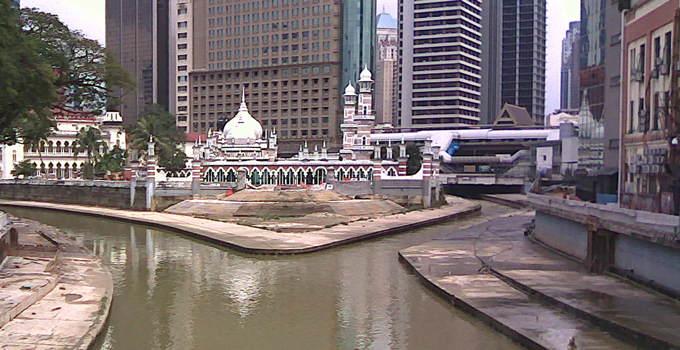
A city’s protection against the impacts of a major flood or frequent flash flooding depends on prior prediction of the timing and severity of the event. It is flood forecasting that provides the warning time needed to activate flood management plans.
In a changing climate in which the intensity and frequency of flood events in many parts of the world is predicted to increase, flood forecasting is a critical component of building climate resilience.
KL gets SMART about flash flooding
Kuala Lumpur’s SMART (‘stormwater management and road tunnel’) project is an innovative flood protection solution incorporating state-of-the-art flood forecasting and detection along with South-East Asia’s longest dual-purpose tunnel.
Kuala Lumpur is Malaysia’s biggest and fastest growing city, built at the confluence of two major rivers. Flash flooding in the city centre causes significant damage and risk to lives and livelihoods. The lost business, damage and clean-up activities caused by these flood events have resulted in significant economic losses.
A number of serious flood events occurred in the years before the SMART project was commissioned, and in its decade of operation since 2007 there have been on average 23 moderate storms per year and around 9 severe or prolonged flood events per year. These would very likely have caused major impacts if the SMART project were not operational.
The idea behind the SMART project is to prevent flash flooding in the city during a typical flood. Floodwaters are diverted away from the city via holding ponds and a tunnel, and then discharged into a river downstream of the city. The infrastructure doesn’t sit idle in dry times – a section of the tunnel is used as a motorway, with two decks of traffic, relieving growing levels of traffic congestion.

The tunnel operates in three modes. Most of the time, when there is little rainfall, there is no discharge of water into the tunnel, which is open to traffic.
In a moderate or minor storm, the tunnel diverts some water flow through the lowest channel of the road tunnel section. The motorway section operates normally and there is no traffic disruption.
In a major storm or when a heavy and prolonged downpour is predicted, the gates at the diversion weir are lowered to divert water flow into a holding pond. Meanwhile, entrances to the motorway section are closed to traffic and vehicles in the tunnel are evacuated. Once empty of cars, the tunnel can be opened to carry a full flow of water. When the weather returns to normal, floodwater is pumped out of the tunnel, which is then cleaned of mud and debris before being reopened to traffic.
Effective protection relies on warning
The innovative and award-winning SMART system depends for its success on the effectiveness of the flood forecasting and detection system underpinning its timely operation.
In the SMART project, flood prediction and detection involve collecting, transmitting, processing and analysing data to forecast storm characteristics. Rainfall and streamflow measurement stations feed into a database and modelling system, providing sufficient warning to clear the tunnel of traffic and open the road deck gates to allow the floodwater to pass through.
The modelling system consists of a coupled hydrological/hydraulic model of the catchment, river channels and tunnel. It draws real-time information from a SCADA system, which retrieves data from instrumentation in the field. This data includes catchment rainfall, streamflow, gate position, pump operation and equipment failure.
The hydrological model is a semi-distributed conceptual rainfall-runoff model, which simulates the soil moisture levels in the catchment over time. The model runs in a warm-up mode, which uses the latest observed data, and in a forecast mode, which generates forecasts of streamflow at key points in the river network two hours into the future.
The hydrological model feeds a hydraulic model, which represents the river channels, storage reservoirs, gates and pumps, and tunnel decks. A series of operating rules for the tunnel infrastructure are programmed into the model, to allow it to adequately forecast flood levels when the tunnel is operated accordingly. The hydraulic model’s major outputs are forecasts of river heights at key locations in the catchment.
The system provides an updated forecast every five minutes, which feeds in to the decision support system for tunnel operators. It’s important that the updates are this fast and frequent to be able to capture the peaks of a catchment that responds very quickly to sudden and intense rainfall.
Modelling in a changing city and climate
The SMART flood detection system is complex and relies on a large network of data. As weather patterns change and as Kuala Lumpur continues to develop, the characteristics of the river channels can change. This means that both the hydrological and hydraulic models must be frequently updated to adequately reflect changes in the systems they represent, such as changes to the catchment, channels, or operation of the SMART tunnel. It is also important to record the history of these changes for calibration against historical flood events.
New developments
The SMART project has a proven track record of mitigating floods in Kuala Lumpur’s city centre; however, operating costs can be high. This includes energy costs for pumping, and the cost of cleaning the tunnel after a successful flood diversion. A review of the flood operating rules is planned for 2018. Revised rules will optimise the operation of the tunnel, to minimise operating costs while still defending the city against flash flooding.
Kuala Lumpur’s robust and accurate flood forecasting and detection system now provides the vital timely warning of floods and their magnitude so that the SMART tunnel can operate successfully to mitigate flood impacts throughout this important city.
It’s a great example of the potential for flood forecasting to save millions of dollars in flood damages, whether in a major metropolis, regional town or rural area anywhere in the world.
To discuss how Entura can help you better manage your flood-related risks, contact Bill Cohen on +61 3 6245 4513, Phillip Ellerton on +61 439 010 172 or Shekhar Prince on +61 412 402 110.
About the author
Bill Cohen is a hydrologist at Entura. He has more than six years of experience in areas of computational hydrology including hydrologic modelling, flood forecasting, and flood estimation. He has been involved in the design and development of flood forecasting systems in Australia and internationally, and has presented at a number of international conferences in recent years.
MORE THOUGHT LEADERSHIP ARTICLES
Maximising the benefits of GIS for better business decisions
‘Location, location, location!’ It’s a familiar catch-phrase in the real estate industry, but it’s just as relevant in the power and water sector. Wherever there’s location-related data, a geographic information system will guide better business decisions.
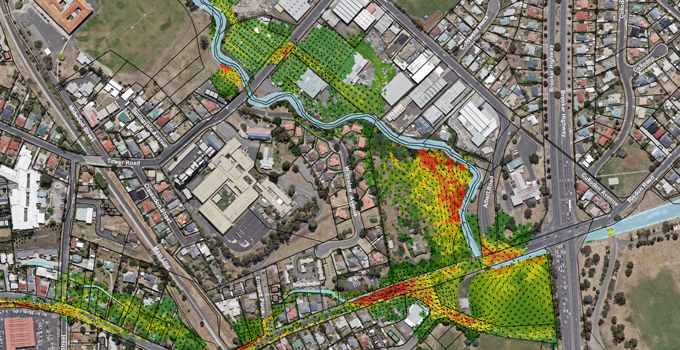
Mobile devices and apps are increasingly using location-based data collected via satellites, drones, LIDAR and other rapidly developing sensing and data capture technologies. With these advances, we are able to find relevant information more quickly and draw on that information to make informed decisions. We’re seeing this proliferate in everyday life through apps that help us navigate, find services and products, and make decisions ranging from the trivial to the profound.
Developers and managers of power and water infrastructure projects who embrace GIS (geographic information systems) stand to gain benefits on an even greater scale. Gathering high-quality spatial information and analysing it to guide business decisions will certainly improve productivity and the bottom line.
Better decisions are the necessary foundation for increased revenue, lower costs, greater efficiency and productivity, and reduced risks. So, if the technology is available and there’s so much to gain, why isn’t GIS being as widely used in the power and water sector as it could be? What may be holding businesses back from fully embracing this powerful and dynamic technology?
Do we really need to use GIS for this project?
All power and water projects involve location – from finding an optimum site for your project, to analysing combinations of spatial data to make the best management decisions or to predict events. Whenever you ask a ‘where?’ question, GIS can help. Where is the asset best located? Where are the constraints or hazards? Where are the reports of previous work done in this area? Where are the customers or opportunities?
In other words, rather than asking whether GIS is needed on a project, consider making GIS a default for every project. The real question should be “how can we maximise the benefits of using spatial data and GIS on this project?” GIS can offer business benefits far beyond the most commonly understood use: making a map.
Data capture in the field can now be streamlined – gone are the days of capturing field data with pen and paper. Users can now collect data on mobile devices, sync to databases while in the field, share data, and generate their own maps, queries and reports. Embracing these advances will save time and enable faster and better decisions.
As well as providing valuable business insights, spatial analysis and location intelligence can greatly improve communication and knowledge sharing – within project teams, with the broader business, and with the community and stakeholders – via tools such as web maps and apps, visual analysis and 3D modelling.
One of the most important applications is the simultaneous analysis of different spatial datasets to provide the best solutions or choices between alternative options, locations, objects and so on. This process is better known as multi-criteria analysis (MCA) and it can be used for many applications.
For example, MCA can be used to find the optimum site for your project taking into account a range of values such as local geology, threatened species, resource availability, land use and terrain, planning restrictions, communities and demographics. Using MCA, you can establish areas of best fit for your project based on thematic overviews of areas of constraint, cost of construction, access and transportation routes.
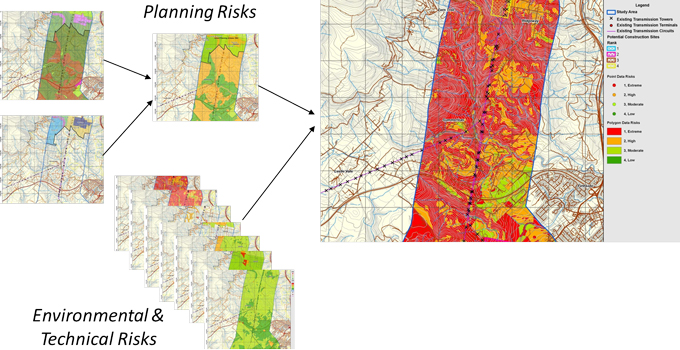
Risks such as bushfire, weeds, threatened species, pollution sources, landslides and erosion can also be more easily and fully understood, supporting your ongoing site management of such issues.
GIS also links with document management, asset management, business intelligence and enterprise resource planning (ERP) systems. It can act as a portal, creating a central point of easy access, pulling together information and making it available on one of the simplest forms to interpret – a map.
Of course GIS is not the answer to everything, and it is not a standalone platform. However, there’s much it can offer across many different business activities, working together with other business systems.
What about the costs?
The return on investment of using GIS should be positive if it is used appropriately. For site selection of power and water projects, using GIS is a no-brainer. For example, using GIS to find the best site for a wind farm – locating the best winds, minimal constraints, good proximity to existing infrastructure and appropriate land use – will obviously result in vastly greater returns than siting the wind farm in an inferior location.
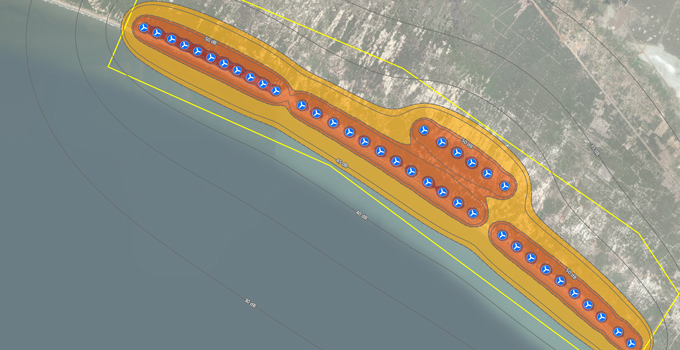
Some examples may be less immediately apparent, but equally valuable – for example, using GIS to increase efficiencies in everyday workflows. If your workers are taking an extra half hour every time they need to find previous work completed in an area, this time can add up quickly. Or perhaps they can’t find previous information, so work is re-done unnecessarily. These costs will keep adding up. Instead you could use a GIS web map to locate all your previous reports and projects, so that a simple click on a map finds the files and saves hours (if not days) of time.
Do we need specialist software or skillsets?
With most things, you do need specialised skillsets and software to get good results, and of course bad data in equals bad data out. Users of GIS do need to understand and assess the spatial data needs in each application.
You could undertake some GIS work yourself using free or open-source software. However, be aware of the risks of using data or tools that aren’t fit for purpose. Just because you know how to use Microsoft Word, doesn’t mean you could write a detailed report outside your area of expertise!
We have seen cases where coarse-resolution data has been used to infer finer project details and costs, resulting in poor decisions. We have also seen inexperienced operators make invalid assumptions. To get the best results, you need to be sure that you’re using the technology wisely.
If you are engaging a power, water or environmental consultant on a project, they are likely to have access to GIS capability; however, GIS is still often underutilised. When deciding who to engage on your project, ask your consultant how they will maximise the benefits of GIS to produce better outcomes for your project.
To discuss how Entura can help you harness the potential of GIS to improve your power and water project decisions and outcomes, contact Stephen Thomas on +61 3 6245 4511, Patrick Pease or Phillip Ellerton on +61 439 010 172.
About the authors
Stephen Thomas is Team Leader and Senior Technical Officer with Entura, specialising in geographic information systems, 3D visualisation and CAD software. Steve has over twenty-six years of technical experience and specialises in environmental assessments and approvals for engineering surveys and property. He has created 3D models and animations of proposed developments including wind farms, urban landscapes and city frameworks. Steve’s work on the Hobart Waterfront 3D model won an international award in geospatial modelling.
MORE THOUGHT LEADERSHIP ARTICLES
Is there an economic case for pumped hydro?
As the proportion of renewable energy in the grid continues to grow, pumped hydro energy storage offers a solution for greater reliability. But can the business case for storage stack up?
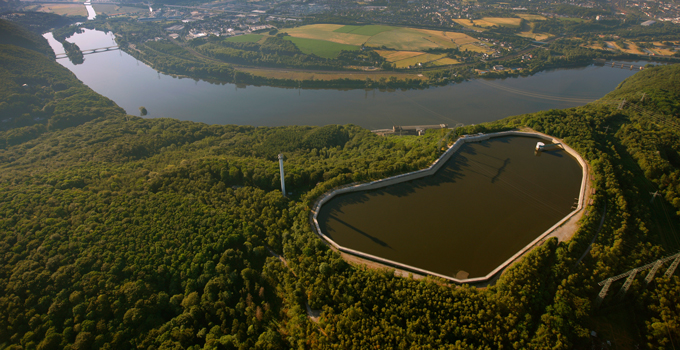
The future is bright for pumped hydro in Australia, and for storage in general. However, no energy solution can exist outside of the real and competitive pressures of the market. Technical viability and environmental benefits won’t be enough to get projects over the line if they can’t demonstrate their financial soundness.
So how can pumped hydro generate sufficient revenue to be attractive to investors? And will that revenue continue to be predictable enough over the longer term?
No doubt there are opportunities, but developers may need to explore a range of different revenue sources in both existing and emerging markets since the arbitrage opportunities of the past may not be present in the future.
Where to for energy arbitrage?
The traditional revenue source for pumped hydro is arbitrage – in other words, making the most of generating when the spot price is high, and pumping when the spot price is low. But this relies on a certain level of predictable variability in the electricity market, and for that variability to continue into the future.
The upcoming retirement of several coal-fired power stations and the continued investment in renewables are likely to cement a market in which variability in power generation and the consequent volatility in energy prices are the norm.
Forecasting revenue – no easy task
Financing an energy project requires a firm revenue forecast. Lenders may consider ‘firm’ to be a 90% confidence limit, which means the developer must demonstrate that the project can generate a certain amount of revenue 90% of the time, or, say, in 9 out of 10 years. This means that a robust and reliable forecast of project utilisation must be made.
Forecasting revenue for an asset with a lifecycle of up to 100 years requires detailed modelling of a wide range of factors influencing the electricity market, including supply (factoring in new entrants, storage, retirements and developments in the thermal sector, etc.), demand (including changes in industrial load, impacts of electric vehicles, etc.), fuel prices, government policies, and bidding strategies for large-scale wind and solar projects.
A business case for pumped hydro relies on all the assumptions that go into regular power plant financial modelling and adds the complexity of arbitrage.
A further complication is the impact on market prices of the presence of the developer’s own project. In other words, how will the proposed project influence the market in which it participates?
For a storage project, the influence is likely to be both an increase in low prices and a decrease in high prices. If the market is robust enough and the proposed project is relatively small, the influence could be minor. However, a very large project is likely to influence the market to such an extent that the utilisation of the project may significantly reduce, which would reduce project returns.
Building a bankable business case
How can the confidence in a forecast be increased enough for a lender to commit funding to a project, given that variance of any one of these assumptions could disrupt the revenue streams for the project? While the transition to a renewables-dominated market continues, it may be that lenders need assurance that other revenue streams exist to reduce the project risk.
Price insurance
High price events in the electricity market will certainly continue to occur, but it’s impossible to predict their timing. Energy storage projects can provide insurance to exposed customers (such as retailers and major industrial customers) through a cap contract in a similar way to gas turbines and other peaking plant. In practice, this may mean that the storage project rarely operates unless the price regularly exceeds the cap.
Network support services
Storage projects have the ability to provide network support services such as frequency control, inertia and fault level control. These services have increasing value in a grid with significant amounts of non-synchronous generation. At this stage, the markets for these network support services are very shallow and competition is increasing. However, the need for such services is likely to increase to the point where more significant markets are required.
Renewable firming
Government energy policy continues to be fluid, yet under the proposed National Energy Guarantee it is possible that there will be value in providing firming services – in other words, pairing ‘dispatchable’ generators (such as storage projects or open-cycle gas turbines) with ‘intermittent’ renewable sources of energy to improve reliability.
‘Behind the meter’ generation
Storage projects are exposed to market prices during both modes of operation (pumping/charging and generating). If, however, there was an option to pump/charge for ‘free’, wouldn’t that reduce the risk?
Genex Power’s world-first Kidston ‘K2 Project’ will pair a 250 MW pumped hydro project with a 270 MW solar PV farm. During the day, solar energy can be used to power the pumps in the pumped storage project. The pumped hydro project will then generate into the evening (and morning) peak. If the upper storage is ‘charged’ during the day, the K2 solar project can generate into the Queensland market and realise the benefits of large-scale generation certificates (LGCs). Of course, this arrangement relies on sufficiently high prices during peaks to recover the additional cost of the solar farm, transmission losses and any LGC liability.
As our electricity mix evolves, so will the economics of storage. While forecasting revenue for storage projects in the Australian electricity market is still an uncertain business, there are many opportunities in both the existing and emerging markets to guarantee project revenues to a level sufficient to satisfy a lender’s requirements.
If you would like to discuss how Entura* can help you with your pumped hydro project, please contact Nick West on +61 408 952 315 or Donald Vaughan on +61 3 6245 4279.
*Entura provides technical advisory services to prospective investors and developers. Financial advisory is not part of our suite of services, however, we partner with financial advisory firms supporting our clients. Entura is the consulting arm of Hydro Tasmania. Hydro Tasmania is licensed (AFSL 279796) to provide general financial product advice. Hydro Tasmania is not licensed to provide nor will it provide advice which considers a person’s objectives, financial situation and needs and you must therefore rely on your own assessment or seek your own independent advice in respect of decisions in relation to any financial product offered.
About the authors
Nick West is a civil engineer at Entura with more than 16 years of experience, primarily in hydraulics and hydropower. Nick’s skills range from the technical analysis of the layout of hydropower projects to the preparation of contractual project documents and computational hydraulic modelling. Nick was a key team member of the Kidston Pumped Storage Project Technical Feasibility Study.
Donald Vaughan is Entura’s Technical Director, Power. He has more than 25 years of experience providing advice on regulatory and technical requirements for generators, substations and transmission systems. Donald specialises in the performance of power systems. His experience with generating units, governors and excitation systems provides a helpful perspective on how the physical electrical network behaves and how it can support the transition to a high renewables environment.
MORE THOUGHT LEADERSHIP ARTICLES
Key considerations for better flood forecasting
Flood forecasting is critical for protecting infrastructure and public safety.
In potentially catastrophic events, effective warnings save lives and avoid costly impacts on property, infrastructure, communities and the environment.
Effective flood forecasting systems provide accurate and timely warning of impending floods . Longer warning times provide greater opportunity to activate emergency management or evacuation plans and to manage water infrastructure.
Successful flood forecasting has obvious applications such as enabling informed operation of a dam to minimise flood peaks downstream, helping determine the need for emergency evacuation, managing river water quality within licensed limits, strategically operating hydropower stations to maximise power generation, or informing the timing or methods of major construction projects such as dams and bridges.
Flood forecasting systems
Flood forecasting systems simulate, display and communicate flood generation processes in a catchment. At the heart of a forecast system is the hydrologic model that converts real-time measured rainfall data and forecasts from weather forecasting agencies or numerical weather prediction (NWP) models into runoff and flow in rivers, or inflows to storages.
For some applications, the hydrologic models can be coupled with hydrodynamic models of the river and surrounding area to provide more accurate representations of flood levels and inundation areas. The forecasts can be displayed graphically on dashboards or mobile phone applications, and automated alerts and warnings can be sent to operators and water managers to manage flood risks.
Warning times and UNCERTAINTIES IN Flood FORECASTING
The chances of effectively managing flood risks improve with longer warning times . However, there is a trade-off between achieving longer forecast warning times and forecast accuracy.
Forecast accuracy depends on the availability and accuracy of the input data (rainfall data, forecasts, and flows) as well as the ability of the hydrologic and/or hydrodynamic model to accurately simulate flood producing mechanism in the catchment.
Flood forecasts based on real-time measured flow data are the most accurate, but they often cannot provide adequate warning times for effective management of flood risks.
Forecasts using observed rainfall data provide slightly longer warning times but also introduce uncertainties. This is because the hydrologic models used to convert rainfall to runoff are a simplified representation of the catchment. They cannot possibly represent all the intricate flood-producing processes that occur in nature.
Warning times are increased by up to a week or more using forecast rainfall data. However, rainfall forecasts are generated using numerical weather prediction models (NWPs) which simulate complex and chaotic processes occurring in the atmosphere and are prone to greater errors and uncertainties.
Despite greater uncertainty, longer term forecasts can indicate that a water manager should keep watch for the possibility of a flood, and can offer more time to ensure that the correct procedures are in place to manage a potential flood risk, and to take actions such as optimum storage management to capture floods.
Importantly, the uncertainty associated with the forecast at longer warning times should be recognised and estimated. Quantification and communication of uncertainty in forecasts provides additional confidence for making decisions about water management.
Seven attributes of superior flood forecasting systems
Investment in a flood forecasting system will provide the best access to the timely, accurate information a water manager needs in adverse conditions.
Entura’s flood forecasting approach involves effective data capture, storage, modelling and dissemination of information. Let’s take a closer look at the features of an optimal flood forecasting system:
|
Accurate data capture from field sensors and available forecasts
|
Data collection sites for flow, rainfall and water-level information must be properly maintained, and any problems with sensors quickly addressed. Automated quality checking is needed to detect major data errors or missing data. There should be redundancy in the network, and routines within the modelling should allow for infilling with data from other sites if one site is out of service. Ideally, a range of possible rainfall forecasts would be included in the modelling to indicate uncertainty in forecast rainfall amounts. |
| Safe storage of all information in a robust database | Storing all data used in forecasting, and the forecasts themselves, allows analysis of the suitability of the input data for forecasting, and analysis of the accuracy of forecasts. Comparison of forecast and actual data can be used to adjust the models. |
|
Optimal modelling and analysis to forecast flows and levels at key locations
|
Hydrologic and hydrodynamic modelling provide flows and water levels at critical points in the system, such as an inflow to a storage, the water level in a reservoir, the water level along a river, or an inundation area in a town. Models should be reviewed periodically with the most recent data to ensure that the parameters are still optimal and that the forecasts are performing as expected. |
| Quantification of uncertainty in the forecast | Ideally, forecasted inflows and levels should be accompanied by indications of the accuracy of the forecast. These are achieved by quantifying uncertainty in the forecast using statistical models and represented as high and low confidence intervals or assignment of probabilities to the forecasts. |
| Automated forecasting run on a schedule | The forecasting system should be fully automated, with the ability to run more frequently in a flood situation if required. Where practical, the system should be fully redundant. A stand-alone system operable with manual data inputs can provide back-up if all communications to a site are lost. |
| Easily interpreted presentation of data and forecasts | Operators and managers need to be able to easily interpret forecasting outputs to make decisions. The visualisation of the data should be tailored for the individual user and include an indication of certainty. Displays may include maps of forecast inundation areas, forecast river levels and flows, or rainfall over a catchment. |
| Timely, automated warnings and alarms | Automated alarms and warnings alert water managers of any forecast floods that may exceed critical thresholds, providing time to ensure appropriate preparation and action. |
In an increasingly volatile climate, with the likelihood of more extreme flood events, an effective flood forecasting system is a critical investment for water managers.
To discuss how Entura can partner with you to develop a best-practice flood forecasting system to help you better manage your flood-related risks, contact Phillip Ellerton on +61 439 010 172 or Shekhar Prince on +61 412 402 110.
MORE THOUGHT LEADERSHIP ARTICLES
Six sink-or-swim questions for the modern dam engineer
Technology and expectations are constantly evolving for the dam engineer but the ultimate goal remains the same: safe, lasting dams. Are you fully equipped to make that target a reality?
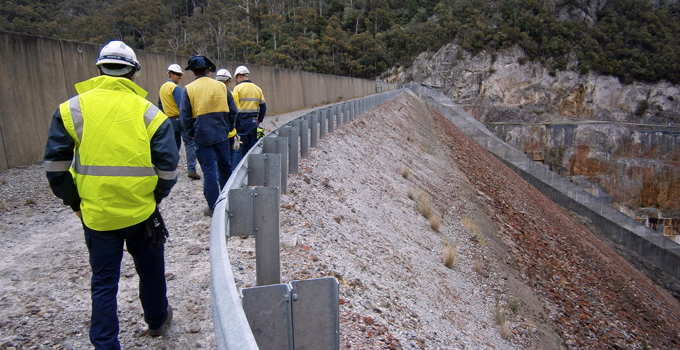
All industries and jobs change over time, but for dam engineers there has been very significant change on many fronts over the last few decades. Improvements and new developments in technology and construction methods are constantly emerging. Expectations of the role continue to broaden beyond technical skills. And, since the 1970s and 1980s, dam engineers have needed to keep abreast of the surge in legislation, regulations and procedures for modern dam safety programs which emerged in the wake of major dam failures.
Of course, generational change is also always occurring. For organisations that have experienced bubbles and dips in the age distribution of their workforce, this is particularly challenging, and gaps may emerge in particular experience brackets. As older engineers move towards retirement, they take with them the knowledge of the generation who designed and constructed older dams that may still retain original technology.
The modern dam engineer therefore faces a dual challenge: not only to stay up to date with the latest technology and requirements, but also to maintain an understanding of older equipment and instruments.
For dam owners and managers, success in your business strategy will depend on ensuring that your dam engineers have the right skills and competencies. Investing in workforce planning and training for your people will help you manage risk, deliver your key functions, and move toward your long-term business goals.
To me, the following key factors are essential for the modern dam engineer to keep on top of our fast-changing profession.
1 – Are you keeping up with changing technology for dam engineering and monitoring?
Dam engineering and monitoring technology keeps improving, and the pace of change gets faster all the time. Defensive measures to ensure the safety of dams have improved greatly over recent decades, such as filters for internal erosion protection, and corrosion protection in ground anchors.
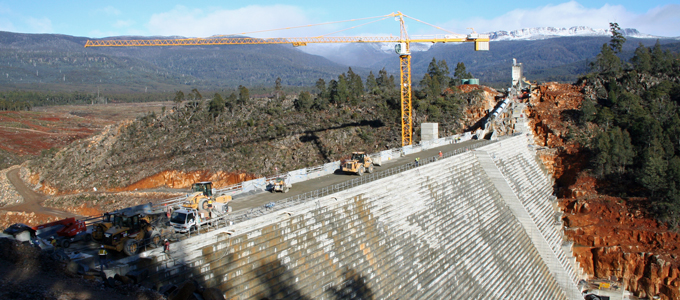
Methods for analysing dams have also become more sophisticated with increased computing power and more advanced analysis software, in particular for extreme floods and non-linear analysis for seismic loading. The modern dam engineer also has access to contemporary geotechnical and structural monitoring instruments, which are useful for interpreting the behaviour of a dam.
It is no longer acceptable for a dam safety engineer to rely only on visual inspection and monitoring data. Modern dam engineers need to understand the underlying design philosophy and keep up with the latest construction practices and their impacts on dam behaviour. We also need to maintain an enhanced understanding of the performance of dam structures and appurtenance structures under various load conditions.
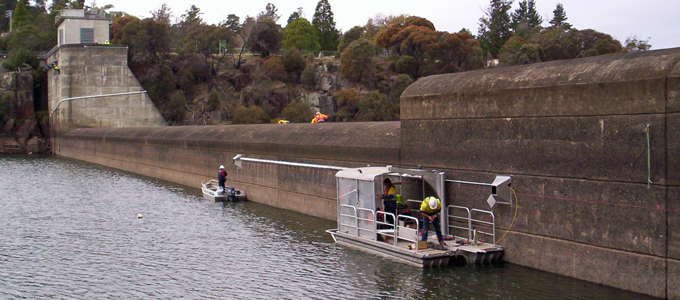
In recent years, advanced instruments and automated data acquisition systems have enabled real-time monitoring of dams and near-continuous time history records for the dam engineer to evaluate.
Dealing with this great volume of data can be very time-consuming and beset by a range of challenges, so it is important that the modern dam engineer embraces the best technological advances to streamline the collection, organisation, interpretation and presentation of the data so that it serves its ultimate function: to quickly identify pertinent issues or anomalies.
2 – Are you guided by risks, with a thorough understanding of failure modes?
The modern dam safety engineer needs a thorough understanding of dam safety risks and assessment practices. Risk assessment now defines the dam surveillance scope and program, and failure modes analysis forms the foundation of a risk-based dam safety and surveillance program.
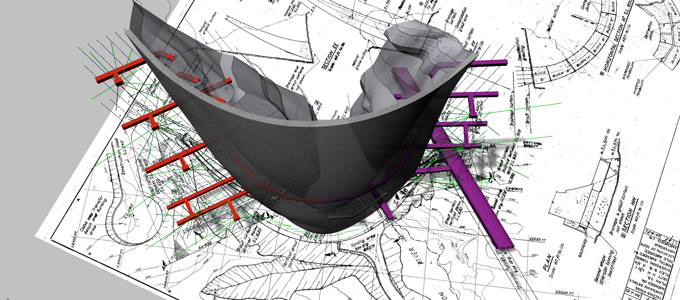
When assessing failure modes, the dam engineer needs to work alongside geologists and construction engineers to understand the impact of construction and to identify features that are not readily visible through visual inspections but could affect the safety of a dam.
3 – Do you consider and understand the impacts of environmental changes?
For dam engineers, consideration of environmental factors is nothing new. However, the potential for changes in weather patterns, and the consequences of these changes, are increasingly important concerns for the modern dam engineer.
In an era in which the climate is changing, dam engineers now need to, for example, consider changes in the size and frequency of rare flood events when evaluating the required spillway capacity, or investigate the adverse impacts on embankment dams during long periods of low rainfall, which could cause desiccation and cracking of the clay material.
4 – How do you prioritise activities within constrained budgets?
Some large dams are now more than 50 years old and are in disrepair or inadequately monitored. However, the limited budgets of public and private sector dam owners can constrain their ability to fund comprehensive surveillance programs and dam remediation works.
This places increasing pressure on the modern dam safety engineer, who should recommend a prioritised program of risk-reduction work within the context of the owner’s financial constraints, to ensure that risks are adequately managed.
5 – Can you engage effectively with the dam’s community and stakeholders?
Dam engineers are increasingly required to consider the safety of dams in the context of the community’s cultural and heritage interests. Community scrutiny of the safety of a dam, or of planned works to improve safety, continues to increase.
With the advent of social media, public scrutiny is now immediate, constant and global. This is a challenge for modern dam engineers, who are not often trained in community engagement.
6 – How safe are your practices?
Over the past two decades, workplace health and safety requirements have had a significant impact on dam engineering. Although not a new responsibility, the regulatory requirements to ensure safe construction, operation, maintenance and decommissioning have increased, requiring modern dam engineers to be aware of legal requirements and safety standards beyond their core skills.
In a world in which the availability and uses of water are increasingly in demand and under strain, we need safe, reliable, enduring dams. Investing in the skills and competencies of modern, professional dam engineers is a critical step towards achieving that goal.
If you would like to talk further about developing your dam engineers, or filling gaps in your own expertise, contact Richard Herweynen, Phillip Ellerton or Dale Bryce.

